NON-FOOTBALL
STORIES 1896
While looking through old documents, it is almost inevitable that the reader's
attention will be drawn from the intended target to other articles. The reports
below were found in old Ardrossan and Saltcoats Heralds. Although they have
no football content, they may be of interest.
STRANGE FIRST FOOT IN ARDROSSAN
A new year incident of an amusing character has just come to light. It appears
that a well-know citizen residing in Princes Street (shown below in the mid
1910s) had just honoured the hoary custom of sitting 'the auld year oot and
the new year in' and having seen a guest to bed was himself about to retire
when he was alarmed by the sound of pattering feet above. Fearing that the noise
came from the guest and apprehensive of the cause, the host sought the bed-chamber
of the visitor where he found everything right but still the noise continued.
I came from above. Down the chimney came the wail "Where am I? I'm wan'ered.".
Host and visitor had recourse to a garret window whence they beheld a man on
the top of the house. The police were called in but when Sergeant Allan arrived,
the nocturnal roof-walker had somehow managed to reach the ground and made off
down the garden which abuts on Princes Lane.
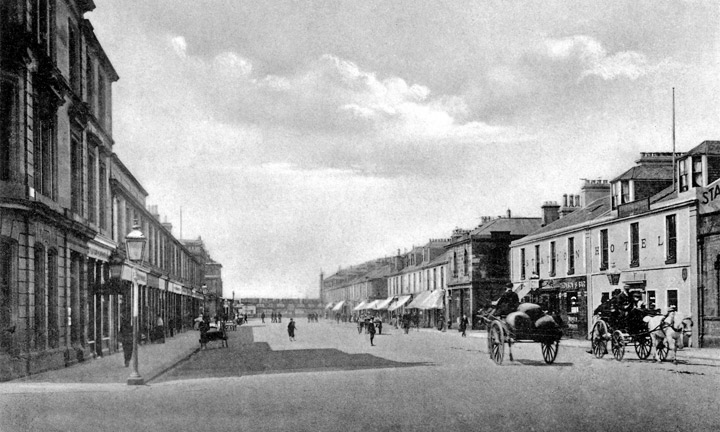
Ardrossan
and Saltcoats Herald, 10 January 1896
RAILWAY EMPLOYEES' GATHERING
The Glasgow and South Western Railway employees at Ardrossan hold their annual
gathering on Friday 14 February.
Ardrossan
and Saltcoats Herald, 31 January 1896
A NIGHT
WITH BURNS
On Friday evening last (24 January 1896), a number of townsmen sat down to supper
in Mrs Fleming's, spirit merchant, Glasgow Street, Ardrossan in commemoration
of the birthday of the poet Burns and also the centenary of his death. An excellent
supper was purveyed by Mrs Fleming in grand style, the tables being decorated
with plants and the Scotch haggis was introduced 'reekin'' with all pomp and
splendour. Song and sentiment followed, The Immortal Memory being accepted with
all honours. A very happy and pleasant evening was spent, the company separating
when few were standing at the corner to the tune of Auld Lang Syne. We are pleased
to note that an interest in such meetings is taken even though it be by but
a few. Nevertheless, this should not be the case, especially with people living
in such an important town as Ardrossan and a town in the county where the poet
was born. A properly constituted Burns Club would add not a little to the credit
of the town.
Ardrossan
and Saltcoats Herald, 31 January 1896
There were references to Ardrossan Burns Club and
Burns Suppers in the Heralds of 27 January 1877,
5
January 1878, 2 February 1878, 4
February 1882, 10 February 1893,
21
January 1898 and 15
February 1901.
CAPTURE OF SEAL IN EGLINTON
DOCK, ARDROSSAN
On Saturday (8 February 1896), a seal was captured in the Eglinton Dock. It
was first observed in the morning and an exciting chase was kept up all forenoon.
About two o'clock, it was shot by Captain Thomas Aguirre of the Spanish steamer
Elena, then lying in the dock. When hauled on board, it was found that the seal
had sustained three bullet wounds on the head. It measured four feet three inches
from the tip of the nose to the tip of the tail and two feet six inches in girth
at the thickest part. It weighed sixty pounds.
Ardrossan
and Saltcoats Herald, 14 February 1896
ARDROSSAN BOWLING CLUB NEEDS
A GREENKEEPER
The Ardrossan Bowling Club (shown below in 2010) is on the lookout for a new
greenkeeper.
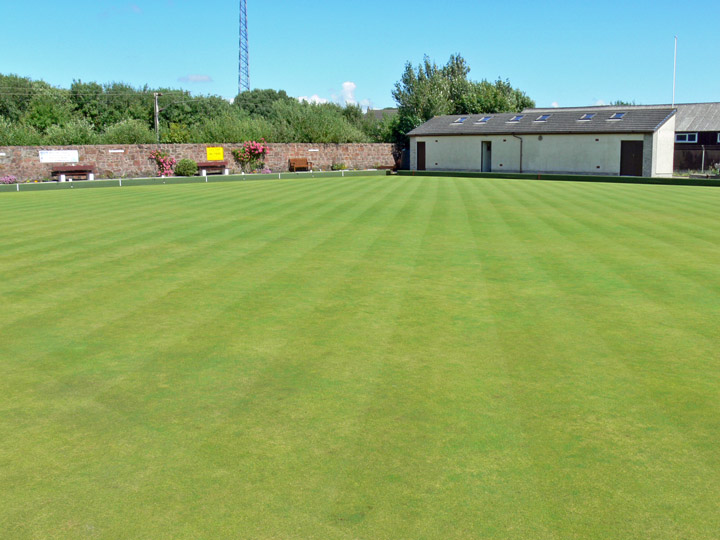
Ardrossan
and Saltcoats Herald, 21 February 1896
SERMON ON TEMPERANCE
In Ardrossan Evangelical Union Church (shown below as the building on the left
with the red door in 1974) on Sabbath evening (16 February 1896), the Reverend
Mr Macgill preached a temperance sermon to young men.
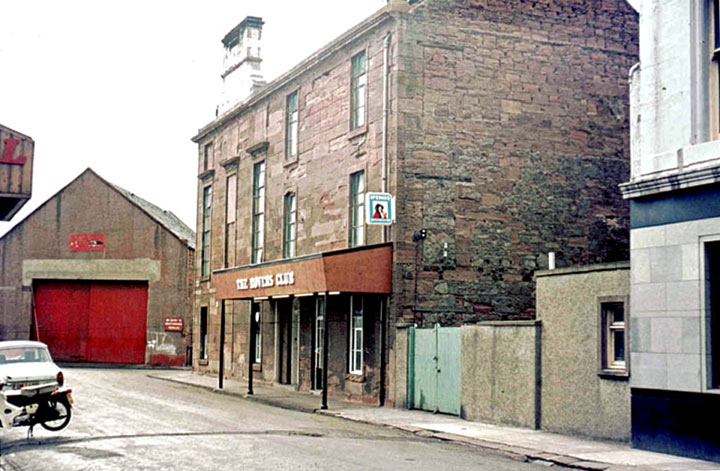
Ardrossan
and Saltcoats Herald, 21 February 1896
PARISH COUNCIL OFFICE FOR
ARDROSSAN?
Parish Councillor Harvey, Ardrossan, thinks there ought to be an office in Ardrossan
for the transaction of the Parish Council business. Most Ardrossan folks think
so too. To the aged poor, Saltcoats seems a good bit away.
Ardrossan
and Saltcoats Herald, 21 February 1896
CHURCH TO BUY COTTAGE AS A
MANSE
The congregation of Ardrossan Independent Church, at a meeting held on Wednesday
evening (4 March 1896), agreed to purchase one of the cottages in course of
erection in Eglinton Street (now Eglinton Road and shown below in the early
1900s) by Mr Henry Wallace, joiner, to be used as a manse.
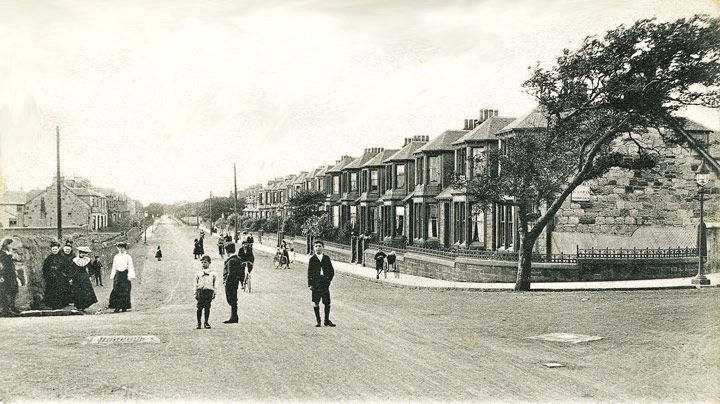
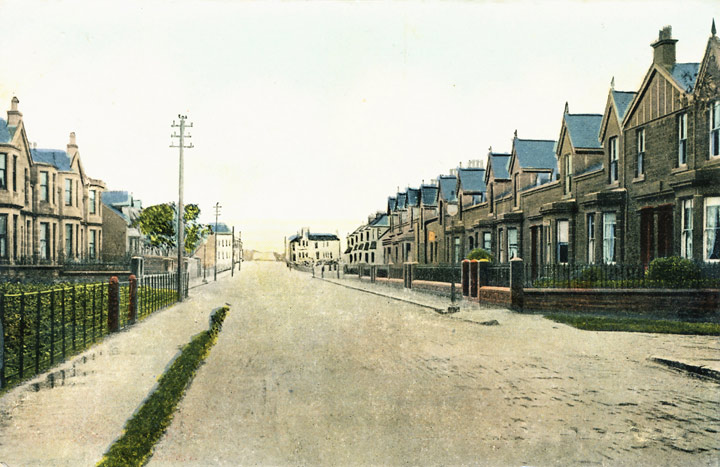
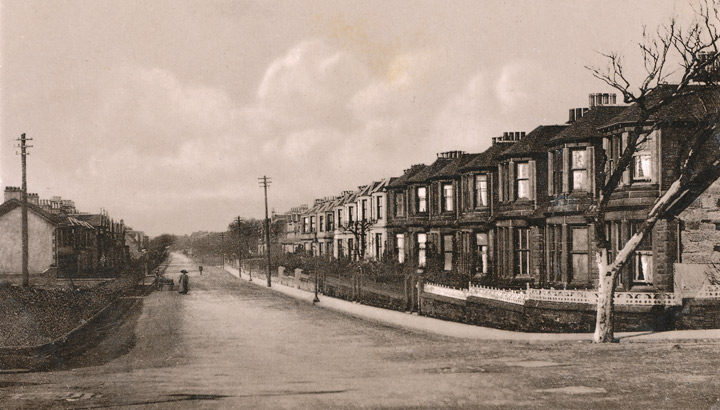
Ardrossan
and Saltcoats Herald, 6 March 1896
AMBULANCE COMPETITION - ARDROSSAN
v GREENOCK IN THE GLASGOW AND SOUTH WESTERN RAILWAY CHALLENGE CUP
The above-named squads again journeyed to Saint Enoch's on Saturday last (29
February 1896) to decide this contest. The time appointed for beginning operations
four o'clock. Both teams were forward in good time and on the names being read
over, they proceeded a little before time to the respective rooms, Greenock
to the oral room and Ardrossan to the practical room. Here they spent half an
hour unravelling doctors' puzzles. They then changed rooms and when time was
up they retired, discussing the chances of success. When recalled, they were
informed that Ardrossan held the honours by one and half points, having scored
158 while Greenock had 156 and a half. The teams then shook hands with one another
and Professor Clark congratulated Mr Nisbet, captain of the winning team on
his ability as an ambulance student. We understand that a concert is likely
to take place in the Assembly Rooms on Thursday next when the cup will be handed
over for the year.
Ardrossan
and Saltcoats Herald, 6 March 1896
UMBRELLAS AND SUNSHADES
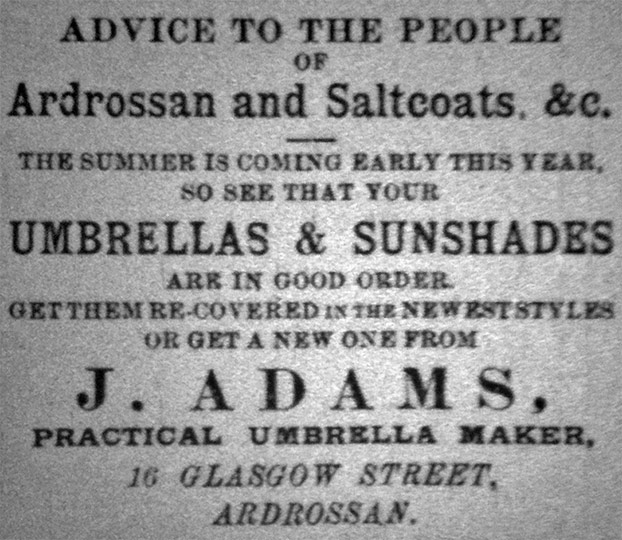
Ardrossan
and Saltcoats Herald, 13 March 1896
ARDROSSAN SHORTHAND TEACHER'S
SUCCESS
Mr William Milne, Ardrossan, was one of the successful candidates at a shorthand
teachers' examination held in London in January by the National Phonographic
Society, the results of which were published in the Phonetic Journal of Saturday
last (7 March 1896).
Ardrossan
and Saltcoats Herald, 13 March 1896
LETTER TO THE EDITOR - SOUTH
BEACH ROAD
Sir
Who is responsible for South Beach Road (shown below in 2011)? Surely it is
not intended it should be left in its miserable condition. Neither street nor
the unfinished footpaths are by any means favourable for vehicles or pedestrians,
particularly in wet weather and for the credit of the Burgh, something ought
to be done to improve matters and to give this road the appearance at least
of being passable in all weathers.
Taxpayer
11 March 1896
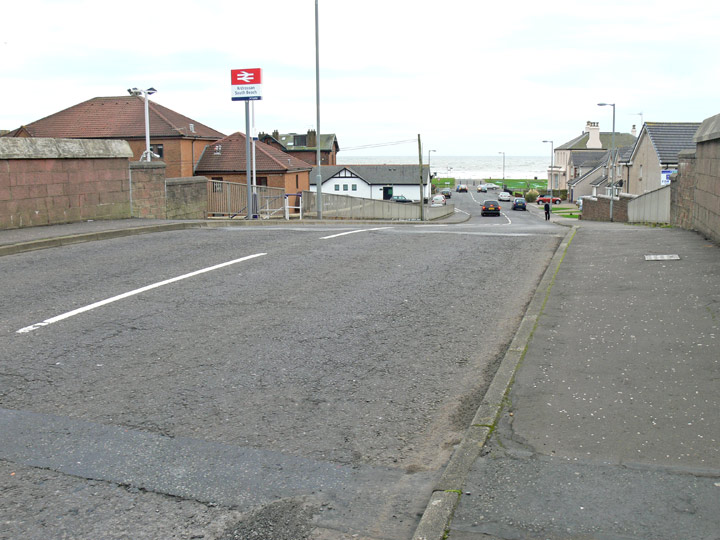
Ardrossan
and Saltcoats Herald, 13 March 1896
EXTENSION TO SAINT ANDREW'S
EPISCOPIAL CHURCH, ARDROSSAN
Important alterations and extensions have been begun on Saint Andrew's Episcopal
Church (shown below in 2002) which involved the completion of the chancel. Only
the choir of the chancel was built when the church was erected and the choir
has hitherto been used as the Sacrarium. An addition of seventeen feet will
be made to the chancel and a new organ is to be erected in the present organ
chamber. The contractors are - Mr Caldwell, Saltcoats, mason; Mr Henry Wallace,
Ardrossan, joiner; Messrs John Hogarth, Ardrossan, slaters and plumbers; Mr
Stobie, Irvine, plasterer and Mr Coombe, Glasgow, heating. The work is expected
to be completed and the church reopened towards the end of June or the beginning
of July.
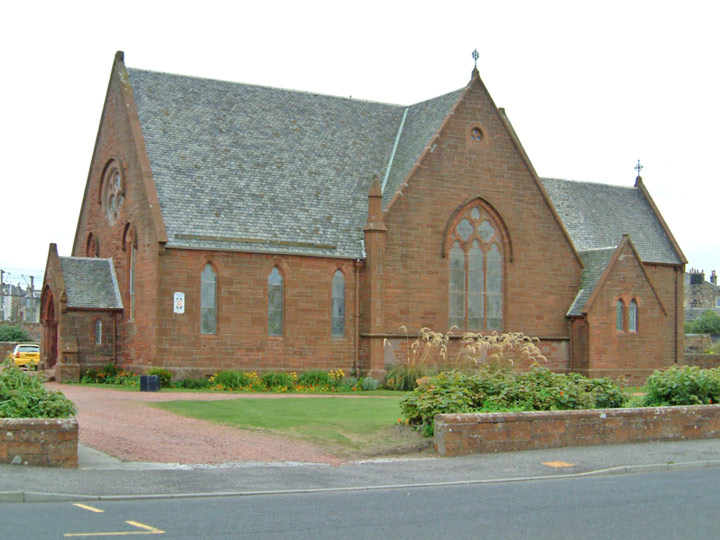
Ardrossan
and Saltcoats Herald, 20 March 1896
ALL FOR A DOSS
At the Justice of the Peace Court in Ardrossan on Monday (16 March 1896), three
vagrants were charged with having slept in a bothy at Auchenharvie Colliery
without permission. Their defence was that they wanted a 'doss' and they emptied
an eight ton waggon or dross to enjoy this luxury. They were convicted and fined
ten shillings or seven days. They went to prison.
Ardrossan
and Saltcoats Herald, 20 March 1896
PIPE ORGAN FOR ARDROSSAN FREE
CHURCH
Ardrossan Free Church (shown below as Saint John's Church in 1913) congregation
contemplate the introduction of a pipe organ. At present, they have only an
American organ but a considerable degree of piping was done on Wednesday night
(25 March 1896) notwithstanding.
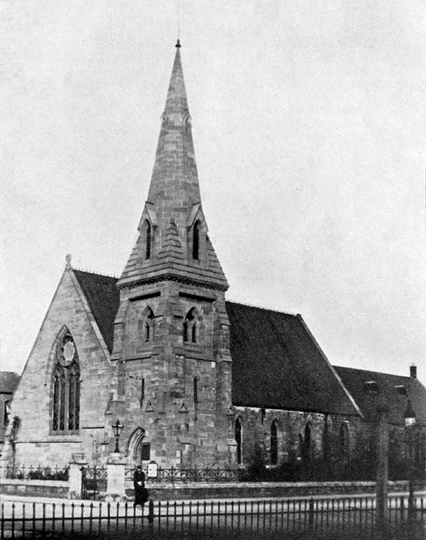
Ardrossan
and Saltcoats Herald, 27 March 1896
MAN INJURED WHEN HOLE CAVES
IN
On Monday morning (30 March 1896), while workmen were engaged in the formation
of a drain at Seton Street, Ardrossan (shown below in 2002), the embankment
at one side gave way falling on one of the men. He, at the time, was making
an excavation in the side near the bottom, this being the cause of the accident.
He was severely bruised about the lower limbs and had to be conveyed home to
Kilwinning in a cab.
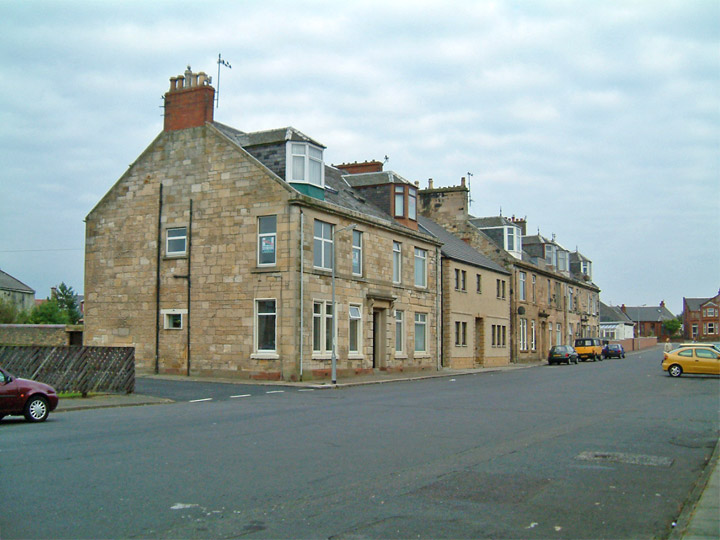
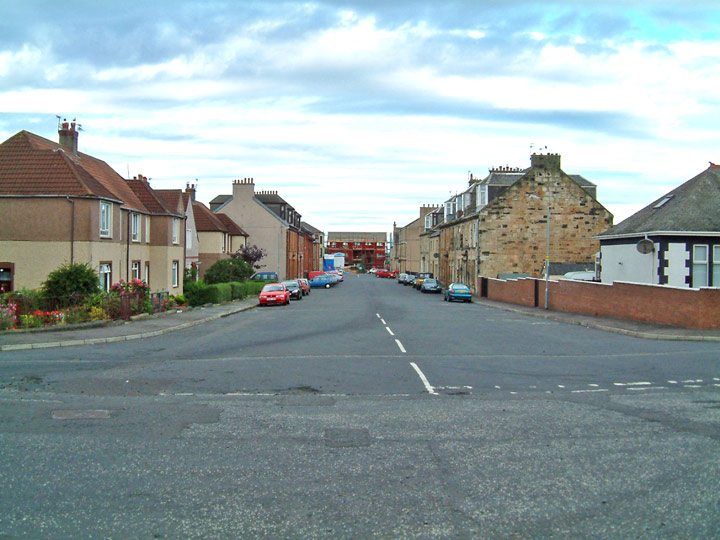
Ardrossan
and Saltcoats Herald, 3 April 1896
BILLIARD CHAMPION VISITS ARDROSSAN
Mr William Green, Scottish champion and a Glasgow gentleman, an amateur, gave
a billiard entertainment in the Conservative Club, Ardrossan, on the evening
of Thursday (27 March 1896) of last week. The game was 600 up all in, the amateur
receiving 300 points. There was a large attendance of members of the club and
friends from Kilwinning, Stevenston, Saltcoats and Ardrossan. The game lasted
a little over and hour and a half. The amateur led with breaks of 54, 40 and
several 20s carefully played. It looked that Mr Green was having his work out
out for him. The Scottish champion, however, was determined not to be the loser
so he pulled himself together with the result that a magnificent display of
science was witnessed by the onlookers. Mr Green's breaks finished at 583, his
opponent being some points short of that score. The amateur then took charge
of the balls and ran out the game. During the game, Mr Green's facility with
'nursery cannons' was frequently applauded as well as the amateur's scoring
from the spot. Mr Robb, president of the club, proposed a vote of thanks to
Mr Green and his friend for their great kindness to the club and expressed the
hope that they might have the pleasure of a similar exhibition at a not far
distant date. The vote of thanks was cordially responded to.
Ardrossan
and Saltcoats Herald, 3 April 1896
ARDROSSAN CYCLE CLUB
At the annual meeting of the above Club, the following office bearers were elected
- honorary president, Thomas Cochrane, member of parliament (shown below in
about 1900); president, Mr J Stevens; vice-president, Mr H Gemmell; captain,
J Stirrat; sub-captain, J Baird and bugler, George Granger. The first run of
the season took place on Wednesday evening (8 April 1896) to Kilwinning, passing
off successfully. This year a strong effort is being made to augment the club
and we hope all cyclists in the district will unite in giving it their support.
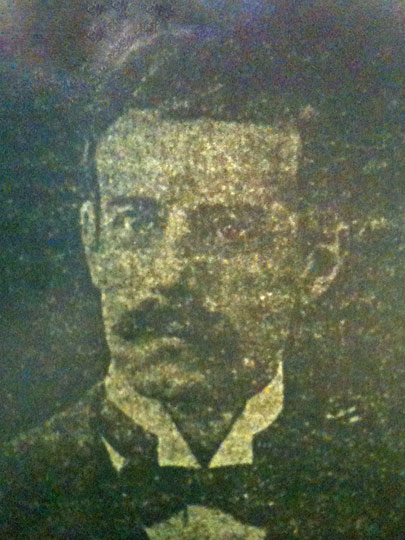
Ardrossan
and Saltcoats Herald, 10 April 1896
ARDROSSAN BOWLING CLUB SUBSCRIPTION
Ardrossan Bowling Club subscription has been fixed at 17s 6d for this season
- an advance of half a crown.
Ardrossan
and Saltcoats Herald, 17 April 1896
SEATS WITH A VIEW
Seats have been provided along the banking between the Caledonian Railway and
the North Shore, Ardrossan (shown below in the early 1910s and 2004). They are
innocent of backs. The locals or the visiting swain my now sit here and tell
his tale in the ear of his listening fair one in full view as such eminently
inspiring things as outlets to drainage pipes and one of the ugliest bits of
wasteland on the Caledonian system. Can't the Commissioners work the Railway
Company or the Harbour Company or both combined? It's years past time something
should be done.
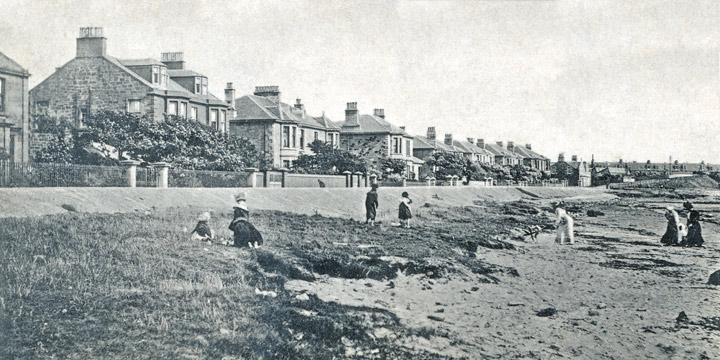
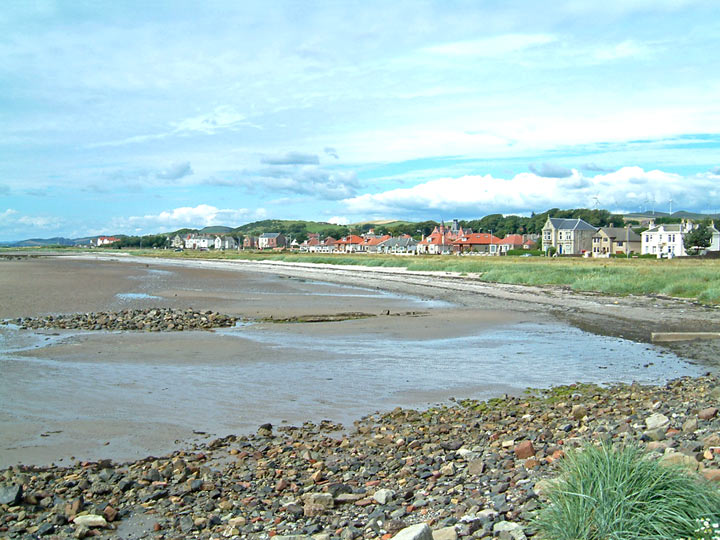
Ardrossan
and Saltcoats Herald, 17 April 1896
NEWSBOY RESCUED FROM ARDROSSAN
HARBOUR
A newsboy, going on board the steamer Duke of Portland in Ardrossan Harbour
(shown below in the early 1900s) on Saturday morning (25 April 1896) fell from
the gangway into the water. He was fished out with a rope, inverted for a few
minutes, then let loose again.
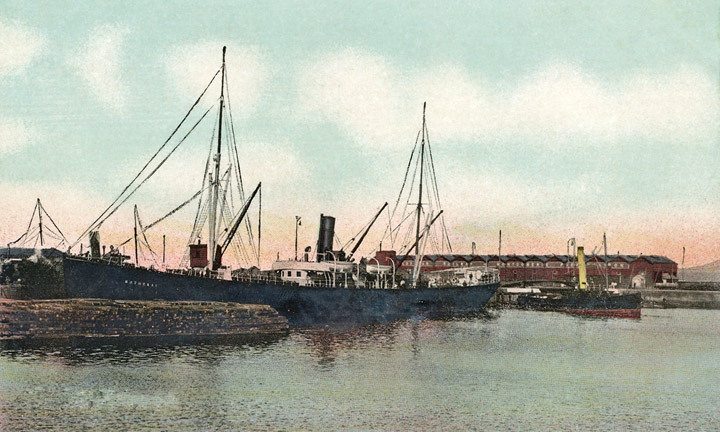
Ardrossan
and Saltcoats Herald, 1 May 1896
HORSE BOLTS IN BARR STREET,
ARDROSSAN
On Wednesday afternoon (28 April 1896), a horse belonging to the Caledonian
Railway Company bolted in Barr Street, Ardrossan (shown below in the mid 1910s),
breaking the shaft of the lorry to which it was yoked. There was nothing in
the lorry but pigs at the time and the pigs were dead.
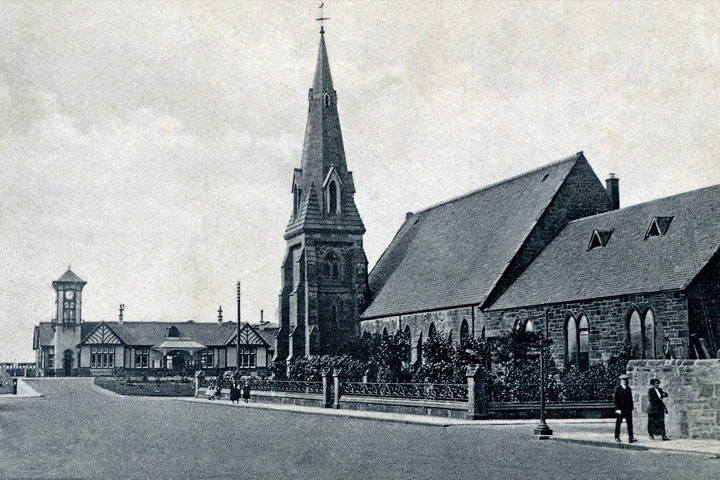
Ardrossan
and Saltcoats Herald, 1 May 1896
ARDROSSAN'S SUNDAY MORALS
SEEM TO NEED SOME IMPROVEMENT
The other Sabbath day (28 April 1896), a football match was carried on in the
public park and if the gamins - for real arabs they were if dress is the criterion
- did not know the rules of the Sabbath, they knew most of the rules of football.
Last Sunday (3 May 1896), there was another case of Sabbath-breaking which took
the form of swinging. The exhibition was not calculated to create the impression
that the participants were making the best suit of the day of rest.
Ardrossan
and Saltcoats Herald, 8 May 1896
ARDROSSAN NEW PARISH CHURCH
- PRESENTATION TO MR HUGH LITTLEJOHN
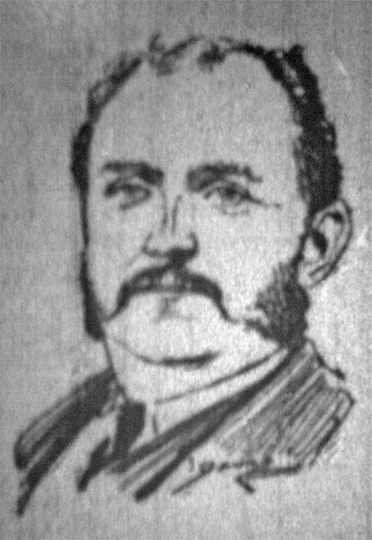 On
Monday evening (11 May 1896), in the hall of Ardrossan New Parish Church, Mr
Hugh Littlejohn (shown right), well-known and esteemed as a townsman and valued
in the congregation in the new Parish Church as a neighbour and genial secretary
and treasurer was presented with a handsome gold watch and chain and also with
a beautiful silver teaset for Mrs Littlejohn. Mr Littlejohn leaves Ardrossan
for Troon. The presentation took place at a meeting held in the church hall
early in the evening at which ex-Bailie Macdonald, South Crescent, presided.
Notwithstanding the early hour - five o'clock - there was a good attendance,
the ladies of the congregation and also gentlemen who had been associated with
Mr Littlejohn in his work being present in goodly number.
On
Monday evening (11 May 1896), in the hall of Ardrossan New Parish Church, Mr
Hugh Littlejohn (shown right), well-known and esteemed as a townsman and valued
in the congregation in the new Parish Church as a neighbour and genial secretary
and treasurer was presented with a handsome gold watch and chain and also with
a beautiful silver teaset for Mrs Littlejohn. Mr Littlejohn leaves Ardrossan
for Troon. The presentation took place at a meeting held in the church hall
early in the evening at which ex-Bailie Macdonald, South Crescent, presided.
Notwithstanding the early hour - five o'clock - there was a good attendance,
the ladies of the congregation and also gentlemen who had been associated with
Mr Littlejohn in his work being present in goodly number.
This is the opening paragraph of a longer report.
Ardrossan
and Saltcoats Herald, 15 May 1896
ARDROSSAN TRAIN TO STOP AT
JOHNSTONE
The 5 am train, Ardrossan to Glasgow, is to be stopped at Johnstone for the
convenience of the workmen.
Ardrossan
and Saltcoats Herald, 15 May 1896
BUILDING IN ARDROSSAN
Building round the old quarry, Ardrossan, proceeds briskly. Mr Boyd, builder,
has taken off feus between the quarry (shown below as disused ground in the
early 1900s) and the houses already built in Eglinton Street. Mr H Wallace contemplates
building nine cottages similar the very handsome buildings he has already erected
on the opposite side of Eglinton Street. Smith Brothers are rapidly populating
the new street in the same neighbourhood. Could not one of the builders not
literally run the quarry to earth by building upon it provided it is first filled
up?
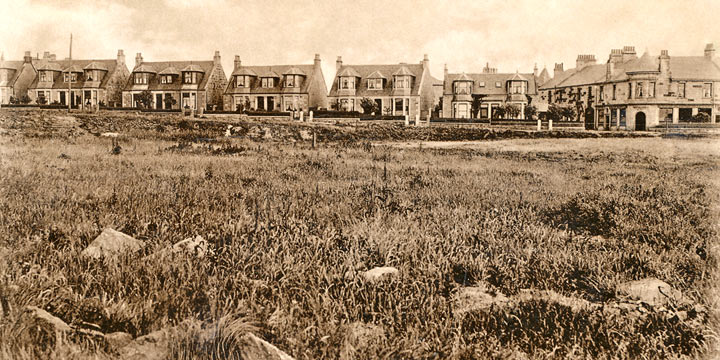
Ardrossan
and Saltcoats Herald, 22 May 1896
HORSE FALLS INTO ARDROSSAN
HARBOUR
Towards the end of last week, a horse employed in the unloading of a boat in
Ardrossan Harbour backed over the quay wall. After being expeditiously relieved
of the carts to which it was yoked, the animal swam across the dock to a pile
of sleepers and was lifted ashore none the worse.
Ardrossan
and Saltcoats Herald, 22 May 1896
SEND FOR DOCTOR JAMESON
It was at the examination of an ambulance class in Ardrossan. Examiner to student
- "Now, suppose you formed one of a party in the heart of Africa with no
medical attendant within thousands of miles and a member of the party got his
leg broken, what would you do?". Student, promptly - "Send for Doctor
Jameson.".
Ardrossan
and Saltcoats Herald, 22 May 1896
FIRE IN ARDROSSAN FOUNDARY
There was a baby fire in the Ardrossan Foundry on Saturday afternoon (16 May
1896).
Ardrossan
and Saltcoats Herald, 22 May 1896
ARDROSSAN VOLUNTEERS HAVE
THEIR MAY MILK
The Ardrossan Volunteers had their annual drink of May milk last Saturday (16
May 1896).
Ardrossan
and Saltcoats Herald, 22 May 1896
ARDROSSAN HELPS CYCLE TRADE
There is a boom in the cycle trade in Birmingham just now. Ardrossan has contributed
largely to that boom.
Ardrossan
and Saltcoats Herald, 22 May 1896
INCREASE IN TRADE AT ARDROSSAN
HARBOUR
Compared with the corresponding period of last year, Ardrossan Harbour shows
for the period of this year to date, an increase in tonnage equal to twenty-five
percent.
Ardrossan
and Saltcoats Herald, 22 May 1896
TRUANT SCHOOL FOR ARDROSSAN?
The motion lying before the School Board of Ardrossan in the name of Mr Shearer
ought to commend itself to the thoughtful consideration of the Board. It proposes
the institution of a central truant school. This question of defaulters is the
most serious and perplexing which School Boards have at present to face. It
is quite common to see half a dozen boys disappear up country and after return
an irate parent with one of the culprits by the ear heading the procession.
It makes one contemplate the future of those boys with serious apprehension
and think more kindly of the fathers some of us have known, who with a familiar
text on their lips, a stout birch in one hand and a squirming boy in the other
discharged the duties of outraged fatherhood with a solemn yet forceful dignity
that left an impression both on the body and on the memory.
Ardrossan
and Saltcoats Herald, 29 May 1896
GIFT FROM ARDROSSAN AMBULANCE
CLASS TO DOCTOR MACDONALD
On Tuesday evening (26 May 1896), Doctor Macdonald, Ardrossan, was waited upon
at his residence by a deputation of students in the Ambulance Class recently
closed at Ardrossan Caledonian station. The deputation consisted of Mr Hepburn,
captain of the Ambulance Corps; Mr George Steel and Mr George Nicol, coal agent.
Mr Hepburn, in the name of the Corps, presented Doctor Macdonald with six volumes
of well-known recent and valuable books on medicine. Mr Hepburn accompanied
the gifts with an eloquent expression of Doctor Macdonald's popularity with
the class. Doctor Macdonald, replying, said he had expressly stipulated at the
beginning of the session that no presentation should mark its close but gratefully
acknowledged the gift.
Ardrossan
and Saltcoats Herald, 29 May 1896
PRICE OF GAS IN ARDROSSAN
TO DROP
Ardrossan gas is likely to be reduced in price probably by five pence per thousand
feet.
Ardrossan
and Saltcoats Herald, 5 June 1896
ARDROSSAN
MAN WINS BANKERS' PRIZE
Mr William Comrie, Ardrossan, is the winner of the second prize - £5 5s
- in connection with the essay competition held under the auspices of the Institute
of Bankers in Scotland.
Ardrossan
and Saltcoats Herald, 5 June 1896
William Comrie also had success
in the 1897 competition.
ARDROSSAN MAN IS TOP CLASS
GLASGOW POLICEMAN
Constable Malcolm Hendry of the Central Division, Glasgow, is an Ardrossan man
and is considered a decided acquisition to the athleticism of the force. He
is an all-round athlete of unusual strength and dexterity.
Ardrossan
and Saltcoats Herald, 12 June 1896
ARDROSSAN QUARRY MAY BE FILLED
There is a reasonable prospect of the open quarry at Eglinton Street, Ardrossan,
being filled up but the Lanarkshire and Ayrshire Railway company does not consider
that the waste ground to the north of the railway station is suitable for a
promenade. Perhaps it is too much to expect a railway company to see that ground
on which they purpose laying down rails is suitable for any other purpose whatever.
Ardrossan
and Saltcoats Herald, 12 June 1896
ARDROSSAN CAPTAIN FEATURES
IN MAGAZINE
Captain Peter Sharp of Ardrossan forms one of the portraits in a new number
of the Strand magazine in connection with an article on heroes of the Albert
Medal. The story of the rescue effected by Captain Sharp and John McIntosh is
well-known to our readers.
Ardrossan
and Saltcoats Herald, 12 June 1896
ARDROSSAN MAN HAS STORY PUBLISHED
IN MAGAZINE
Mr C J Shearer, Ardrossan, contributes a complete story entitled Death In The
Alps to the July number of a Blackwood's magazine.
Ardrossan
and Saltcoats Herald, 19 June 1896
THOUSANDS OF HOLIDAYMAKERS
IN ARDROSSAN
On Saturday last (13 June 1896), there were 2000 Bridgeton Cooperators and 1050
Paisley Sabbath Schoolchildren on holiday in Ardrossan.
Ardrossan
and Saltcoats Herald, 19 June 1896
PURE WATER WANTED IN ARDROSSAN
Pure water is much sought after in the lower reaches of the town of Ardrossan.
Two cases are reported in which the liquid presently supplied was so thick as
to choke the delivery pipes.
Ardrossan
and Saltcoats Herald, 26 June 1896
ARDROSSAN CATTLE-SHED LODGERS
One of the oddest midnight scenes Ardrossan has furnished for a long time was
witnessed by a solitary pedestrian on Sunday night (21 June 1896). A long line
of tramps - eleven men - nearly the same number of women and a big batch of
children - with an occasional policeman, three in all, sandwiched in between
fell slowly down Glasgow Street. The eleven men appeared at the Burgh Court
on Monday morning where it transpired that they had been lodging in a cattle-shed
at Chapelhill Farm (shown below in 1974) without permission. They were each
sentenced to pay a fine of seven shillings and sixpence or go to prison for
five days.
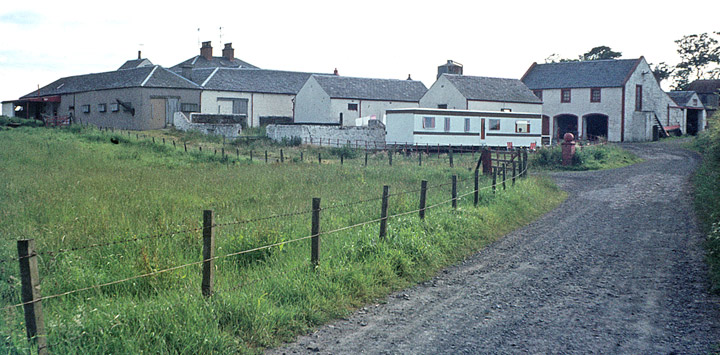
Ardrossan
and Saltcoats Herald, 26 June 1896
WARM WELCOME FOR ARDROSSAN
MINISTER
When the Reverend Donald Craig made his first appearance at the Ardrossan Presbytery
on Tuesday last (30 June 1896), his entrance was signalled by a hearty round
of applause from his fellow presbyters.
Ardrossan
and Saltcoats Herald, 3 July 1896
ARDROSSAN QUARRY TOO OPEN
In addition to the entrance by the gate which continues to be left open at the
quarry hole, Ardrossan, there is now a gap in the fence wide enough to admit
half-a-dozen urchins abreast.
Ardrossan
and Saltcoats Herald, 3 July 1896
ARDROSSAN HARBOUR TO BE LIT
BY ELECTRICITY
Preparations are being made for electricity for lighting the whole of Ardrossan
Harbour by electricity.
Ardrossan
and Saltcoats Herald, 10 July 1896
ARDROSSAN BATHING FACILITIES
Visitors should know that Ardrossan possesses a bathing house for gentlemen
and also one for ladies. The boats for hire at The Inches (shown below in 2003)
are excellent.
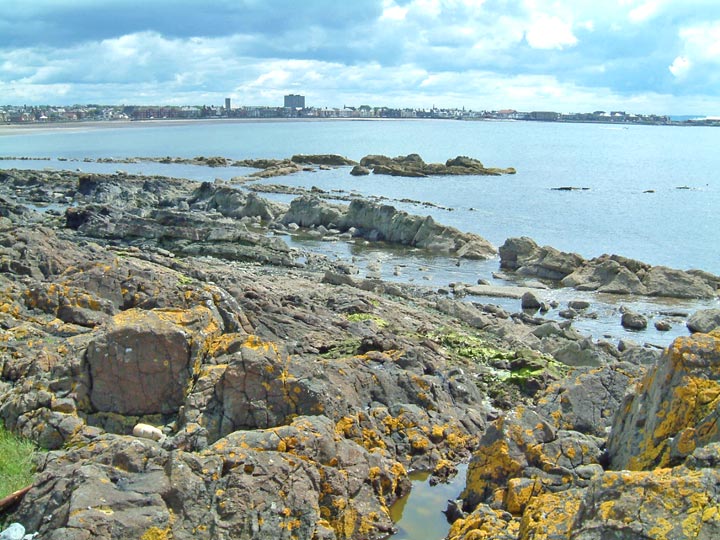
Ardrossan
and Saltcoats Herald, 10 July 1896
IMPROVEMENTS TO GLASGOW STREET,
ARDROSSAN
Glasgow Street, Ardrossan (shown below in the early 1900s), is improving its
appearance. The new premises, the better pavements, the freshening of the United
Presbyterian Church and plants on certain window-sills have a brightening effect.
If the last-named feature were more frequent, the monotony of the street would
be somewhat diversified.
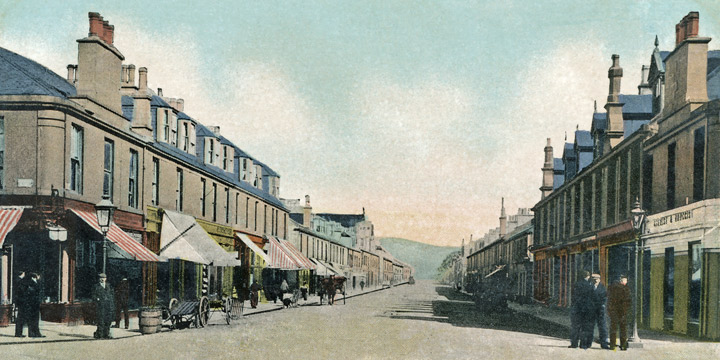
Ardrossan
and Saltcoats Herald, 10 July 1896
REPEAT OFFENDER
At Ardrossan Burgh Court on Friday (3 July 1896), a man was fined thirty shillings
or twenty-one days for assaulting a lodging-house keeper and her daughter. At
the same court, on the same day, the same man was fined five guineas with an
alternative of two months imprisonment for assaulting a policeman by hitting
him on the nose.
Ardrossan
and Saltcoats Herald, 10 July 1896
FINED FOR FURIOUS DRIVING
A driver in the employment of Ardrossan Cooperative Society was at Monday's
(20 July 1896) Burgh Court convicted on a charge of furious driving and fined
ten shillings and sixpence.
Ardrossan
and Saltcoats Herald, 24 July 1896
EXTENSION OF DRAINAGE PIPE
The decision of Ardrossan Commissioners to extend the drainage pipe at Montgomerie
Pier is meeting with the approval it deserves. The extension follows naturally
and necessarily upon the abolition of ashpits and the adoption of water closets
in the town.
Ardrossan
and Saltcoats Herald, 24 July 1896
MAN OVERBOARD
On Tuesday night (21 July 1896), about ten o'clock, a seaman fell from a steamer
coming into the dock. A shipmate jumped in after him to render assistance. Pilot
Melvin was at hand with a buoy and both men were picked up.
Ardrossan
and Saltcoats Herald, 24 July 1896
TELEPHONE CALL BETWEEN ARDROSSAN
AND LONDON
A conversation by telephone was engaged in the other day between Ardrossan and
London. The atmospheric conditions were good and the messages were agreeably
distinct.
Ardrossan
and Saltcoats Herald, 31 July 1896
CONVICTION FOR PLYING A HORSE
WITHOUT PERMISSION
At Ardrossan Burgh Court on Monday (27 July 1896), a labourer employed by a
Saltcoats hirer was convicted under the 381st section, sub-section I of the
Burgh Police Act 1892 of plying a horse for hire on South Beach, Ardrossan (shown
below in the early 1900s), without having first obtained permission of the magistrates.
He was admonished.
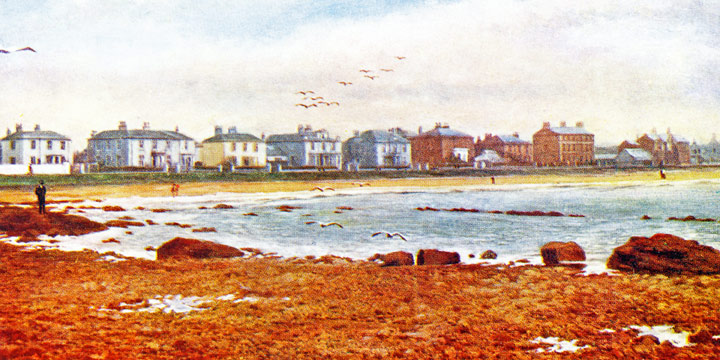
Ardrossan
and Saltcoats Herald, 31 July 1896
MERCHANTS' HOLIDAY
Wednesday last (29 July 1896) was a holiday among merchants in many parts of
the country. On the run from Ardrossan to Stranraer and back, the Glen Sannox
was crowded with local merchants and their friends.
Ardrossan
and Saltcoats Herald, 7 August 1896
KILWINNING LODGE TO AMALGAMATE
WITH SALTCOATS AND ARDROSSAN?
A motion has been tabled in Lodge Neptune Kilwinning Ardrossan number 442 which
asks the members to agree to official enquiry being made of their brethren in
Lodge Saltcoats and Ardrossan Saint John's Royal Arch number 320 as to whether
they feel disposed to consider the question of amalgamation.
Ardrossan
and Saltcoats Herald, 7 August 1896
ARDROSSAN ROAD IN POOR CONDITION
The attention of the Ardrossan authorities is directed to the condition of the
road leading from the main road to the bridge which spans the Stanley Burn.
It is rough in the extreme and contrasts unfavourably with the portion of the
same road under the jurisdiction of the Saltcoats Burgh.
Ardrossan
and Saltcoats Herald, 7 August 1896
NEW FILTER OPENED IN ARDROSSAN
Commissioner Gray turned on the water at the new filter at Mill Glen, Ardrossan,
on Tuesday forenoon (4 August 1896). The new filter doubles the supply from
Mill Glen and rids the town of the objectionable necessity of drawing the supply
direct from the reservoir when cleaning or repairing has to be performed. Commissioner
Gray has been very active in this work.
Ardrossan
and Saltcoats Herald, 7 August 1896
REDUCTION IN PRICE OF GAS
Gas in Ardrossan has been reduced by ten pence per thousand feet. The Commissioners
deserve hearty commendations.
Ardrossan
and Saltcoats Herald, 7 August 1896
REDUCTION IN PRICE OF GAS
A reader reminds us this week that though the administration of Ardrossan Gasworks
by the Commissioners has in the past led to the reduction just effected in the
price of gas, this would have been impossible but for the able, careful and
conscientious management of Mr Galbraith.
Ardrossan
and Saltcoats Herald, 14 August 1896
ARDROSSAN HOSPITAL
The Ardrossan Hospital comedy seems likely to end tamely after all. The last
act - let us hope it may have few scenes - is a sham fight in which the combatants
are four lawyers.
Ardrossan
and Saltcoats Herald, 14 August 1896
ARDROSSAN ICE-CREAM MAN FINED
The Italian ice-cream man who carries on business in Princes Street, Ardrossan,
was fined at Monday's (10 August 1896) Burgh Court for keeping his premises
open until 12:20 on Sunday morning.
Ardrossan
and Saltcoats Herald, 14 August 1896
LORD EGLINTON AS PROVOST OF
ARDROSSAN?
The Marquis of Bute has agreed to become Provost of Rothesay. Ardrossan should
make overtures to Lord Eglinton.
Ardrossan
and Saltcoats Herald, 21 August 1896
BROKEN LEG ON HORSE ISLAND,
ARDROSSAN
On Tuesday (18 August 1896), a Kilmaurs lassie accompanied by a male relative
from Ardrossan and another friend visited the Horse Island (shown below in 2011).
The voyage proved eventful. The fair visitor stumbled, breaking her leg at the
ankle. The Ardrossan relative. being an ambulance man, set the injured limb
to rights and on the return to civilisation, medical aid was called in.
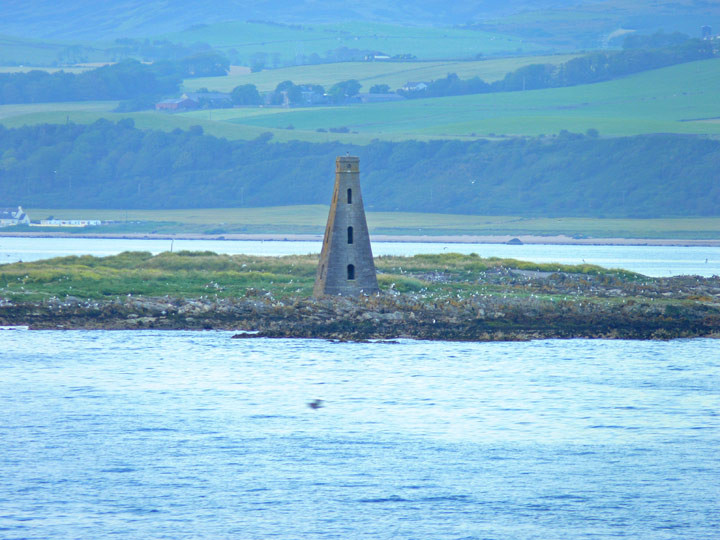
Ardrossan
and Saltcoats Herald, 21 August 1896
ARDROSSAN CYCLING CLUB RACE
The Ardrossan Cycling Club, which has a membership of twenty-six, is desirous
of promoting a time race to Gourock and back, a distance of fifty-four miles.
A few prizes would be most acceptable.
Ardrossan
and Saltcoats Herald, 28 August 1896
MACHINE BEING BUILT ON THE
INCHES, ARDROSSAN
The colossal machine being erected on The Inches, Ardrossan (shown below in
2003) by Messrs Christie is termed a transporter. It will be used in connection
with the piling of sleepers. Possibly its main advantage is that it admits of
sleepers being piled to a greater height that usual and with less danger than
by the ordinary method.

Ardrossan
and Saltcoats Herald, 28 August 1896
LETTER TO THE EDITOR - A LOOK
TO THE FUTURE
Sir
Saltcoats and Ardrossan Burghs are now united and some day will be under one
jurisdiction. One larger area will cost less in proportion to govern than two
smaller separate areas. Gas could be supplied cheaper. The permanent officials
would be reduced in number and water should also be cheaper. That the two Burghs
will be one at no very distant date is a reasonable view to take and not all
that Utopian. One difficulty to be faced is the duplicating of the names of
streets. At the present moment, this is leading to confusion and annoyance.
There is a Caledonia Road off North Crescent, Ardrossan and a Caledonia Road,
Saltcoats. Saltcoats Caledonia Road now runs into Ardrossan Burgh and unless
this portion is named by the Ardrossan Commissioners, say Sorbie Road, which
they are entitled to do, confusion might be worse confounded. The Town Clerks
might consult each other when new streets are named. Might I draw the attention
of the Ardrossan Burgh Commissioners to the state of the road under their charge
leading from South Crescent to Montgomerie Crescent. Their part has not been
made up to anything but a credit to them. A stone crossing would also be an
advantage.
Yours truly
Alexander Wood
Thornly
Saltcoats
3 September 1896

Ardrossan
and Saltcoats Herald, 4 September 1896
ADDRESS ON MISSION WORK AMONG
SEAMEN
An address upon mission work among seamen will, as announced, be given in Ardrossan
United Presbyterian Church Hall tonight (11 September 1896). We bespeak for
the Reverend T S Hatfield, association secretary, a large attendance.
Ardrossan
and Saltcoats Herald, 11 September 1896
MONTGOMERIE STREET, ARDROSSAN,
CLOSED
Montgomerie Street, Ardrossan (shown below in 2003), as far up as Barr Lane,
is closed against vehicular traffic just now in consequence of the new pipe
drain which is about tot replace the old built one. The change has not come
too soon.
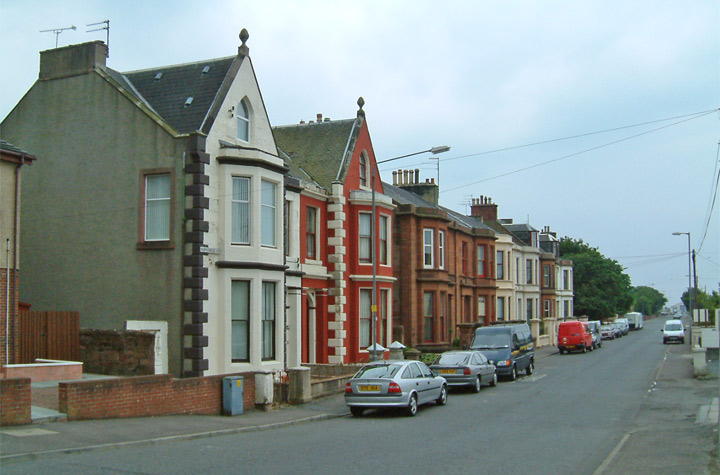
Ardrossan
and Saltcoats Herald, 18 September 1896
ARDROSSAN DOG SHOW
For the success of Ardrossan Dog Show last Saturday (12 September 1896), much
credit is due to the committee and office bearers of the society. Courtesy and
good temper failed no-one during the exceedingly trying time.
Ardrossan
and Saltcoats Herald, 18 September 1896
FARMS LEASED TO ARDROSSAN
MAN
The extensive dairy and sheep farms of Boghead and Welltress on the Auchinleck
house estate have been let on lease to Mr Andrew Bickett, Knockrivoch, Ardrossan.
Ardrossan
and Saltcoats Herald, 2 October 1896
ARDROSSAN ACADEMY TECHNICAL
EDUCATION CLASSES
The classes in technical education were opened in Ardrossan Academy (shown below
as the ruins of Saint Peter's School in 2002) on Tuesday (15 September 1896).
The attendance was not so large as it might have been. Every young mechanic
in the district should make a point to join the class. There is still plenty
of time.
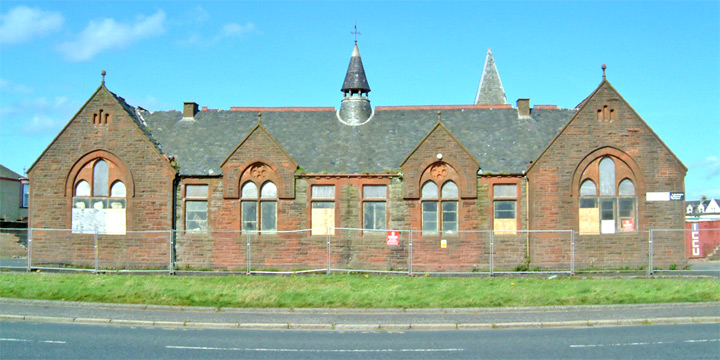
Ardrossan
and Saltcoats Herald, 2 October 1896
POLICE RAID ON SHEBEEN IN
PRINCES STREET, ARDROSSAN
Sergeant David Allan and two policemen made a raid on an alleged shebeen in
Princes Lane, Ardrossan, on Monday morning last (5 October 1896). The raid was
completely successful. The accused will appear at a special Justice of the Peace
Court today (9 October 1896).
Ardrossan
and Saltcoats Herald, 9 October 1896
PRESENTATION TO ARDROSSAN
GROCER'S ASSISTANT
Last night (8 October 1896), Mr James Watson, grocer's assistant, Ardrossan
was entertained to supper by a number of friends and presented a meerschaum
pipe, tobacco pouch and cigar case on the occasion of his approaching marriage.
Captain John Kerr, wine and spirit merchant, made the presentation. In the course
of a humorous and cordial speech, Captain Kerr commended Mr Watson on the pluck
and prudence he displayed in taking the step he contemplated. In handing over
the gifts, he said that he had no doubt the fragrant weed had no doubt beguiled
the lonely hours of Mr Watson's bachelorhood and he had as little doubt that
it would be the solace to which he would have recourse after the occasional,
very occasional, breezes that were believed to lend variety to married bliss.
He concluded by expressing all good wishes to Mr Watson and his future partner
in life. Mr Watson made an eminently suitable reply.
Ardrossan
and Saltcoats Herald, 9 October 1896
ARDROSSAN'S HARRIERS' CLUB
Now is the season for cross-county runners and in connection with the recently-formed
Ardrossan Football Club, we understand that a Harriers' Club has been organised.
This latter venture in new to the district but we see no reason why it should
not find favour with some of our local athletes. The Club has several members
enrolled and as these cross-country youths have got into harness. One or two
short runs have already been made. During the season the members of the club
might arrange for an inter-run with some neighbouring club. An impetus might
thereby be given to this kind of sport and who knows that some of those cross-country
runners might yet earn distinction on the racing path. We understand the promoters
of the above clubs purpose holding a concert on an early date.
Ardrossan
and Saltcoats Herald, 16 October 1896
POLICE CONSTABLES MOVE
Constable Smith of Ardrossan has been removed to Largs and his place taken by
Constable Macpherson.
Ardrossan
and Saltcoats Herald, 16 October 1896
ARDROSSAN PARISH COUNCIL OFFICE
AND ROOMS OPENING SOON
The Parish Council office and rooms at 55 Glasgow Street, Ardrossan will shortly
be opened for the transaction of business. It is said there is to be a 'house-heating'.
Ardrossan
and Saltcoats Herald, 16 October 1896
SCOTLAND'S SECOND FASTEST
TRAIN
In a table giving the speed of trains, the run between Ardrossan and Paisley
stands second highest at 58.2 miles per hour, a speed only exceeded by the run
between Perth and Forfar which is 60.9 miles per hour.
Ardrossan
and Saltcoats Herald, 16 October 1896
AUTUMN AND WINTER NOVELTIES
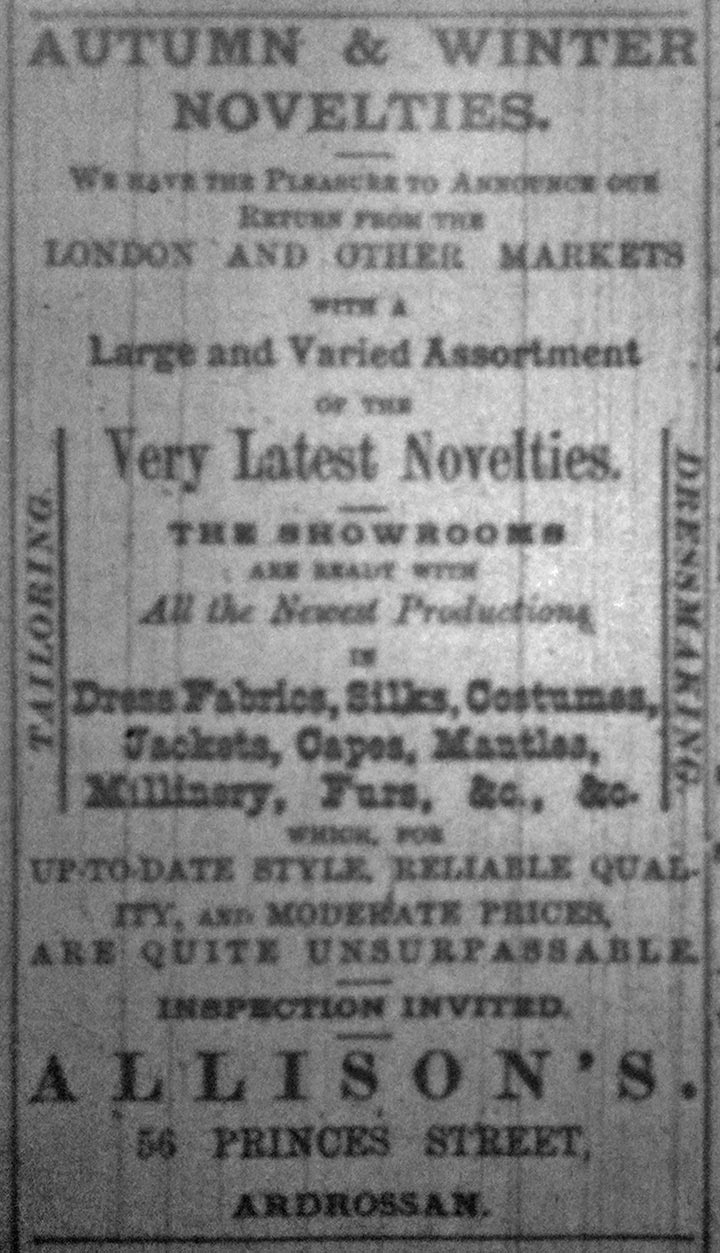
Ardrossan
and Saltcoats Herald, 23 October 1896
GIRLS SMOKING IN ARDROSSAN
In South Crescent, Ardrossan (shown below in the early 1900s) on Monday evening
(19 October 1896), two girls were observed in the enjoyment of a social whiff
at a cigarette. A correspondent requests that we should commend the modest clay
pipe as both healthier and cheaper.
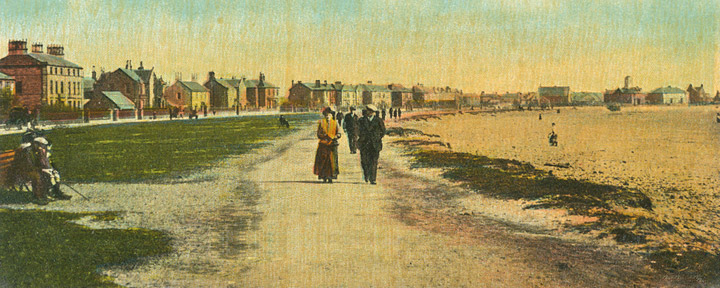
Ardrossan
and Saltcoats Herald, 23 October 1896
FIFTY YEARS OF ARDROSSAN AS
A BURGH
Four years ago in 1892, when the New Eglinton Dock was opened for traffic,
as sketch was given of the origin of the town and growth of the harbour. The
data then embodied need not be repeated. Ten years hence, the hundredth year
will no doubt be celebrated with becoming honours. Today, we celebrate the jubilee
of the Burgh! The proposal to erect 'the town or village of Ardrossan and
places adjacent in the county of Ayr into a Burgh of Barony for paving, lighting
and cleansing the same, for establishing a police therein, and for other purposes
relating thereto' originated with Doctor McFadzean whose portrait hands
in the Town Hall (shown below in the early 1890s) and a monument (shown below
as MacFadzean's Monument in 2006) to whose memory stands on the Cannon Hill.
He had come to reside in the place and when he died on 8 January 1849, aged
sixty, the poor of Ardrossan and neighbourhood mourned the loss of a friend
who had professionally visited their sick and dying and the whole community
a resident who had shown undaunting zeal in the promotion of those measures
and institutions which had for their object the moral and religious welfare
of the inhabitants of the town of his adoption. He was associated with the promoters
- indeed was the principal promoter - in the erection in 1844 of the New Parish
Church of Ardrossan and to Mrs McFadzean, the town was indebted for the Female
School of Industry, erected in 1846 in Glasgow Street 'with the view of promoting
education amongst girls and young boys, children of the poor in the town of
Ardrossan'. The proposal to erect the town into a Burgh was opposed, as
all such proposals are still unfortunately, opposed on the pleas that rates
would be levied and local burdens increased. The leader of the opposition was
John Barr, afterwards Provost Barr, who being a large employer of labour, was
able to evoke a great deal of public feeling but the promoters made out a good
case before the Parliamentary Committee and having the support of the Earl of
Eglinton, the Act sought for received the royal assent on 16 July 1846. The
Act was limited to thirty-one years form its passing so far as related to police
purposes and when these lapsed in 1877, the provisions of the Police and Improvement
Act were adopted. In this connection, it is of interest to note that Ardrossan
was, so far as we know, the first place that had for Municipal purposes, a household
franchise. An extract from Clause four is 'that the right of electing and
being elected Members of Council in the said Burgh shall be vested in all Persons
who are Tenants and Occupiers or Owners or Life Renters either in their own
Right or in the Right of their wives of Heritable Subjects within the limits
of this Act, liable to be assessed under the provisions of this Act of a Yearly
Rent or Value of Five Pounds or upwards'. When the extension of the Franchise
for Parliamentary elections was being discussed, Mr Craufurd of Auchenames,
Member of Parliament for the Ayr Burghs, called attention to the clause and
the powers it gave and was told that it was passed by an overlook, the Municipal
qualification being always the same as that for the election of Members of Parliament.
Defeated in Parliament, the opposing party determined on capturing the Commission
Board, an easy matter when it is considered that shipbuilding was the chief
industry in the place . The first election took place on the first Tuesday of
November 1846 and the voting placed the following at the head of the poll -
John Barr, James Willock, William Fullerton, Adam Barrie, Peter Barclay, William
Ford junior, Archibald Russell, John King and James Shearer - all good men for
the office. Clause six of the Act provided that the Sheriff should be the returning
officer at the election and also the declaration of acceptance or declinature
of office should be given on the second lawful day thereafter. At a meeting
on 6 November 1846, the following were elected to Municipal offices: John Barr
-Provost, James Willock and William Fullerton - Senior and Junior Bailies, Adam
Barrie - Treasurer and James O Mack -Town Clerk.
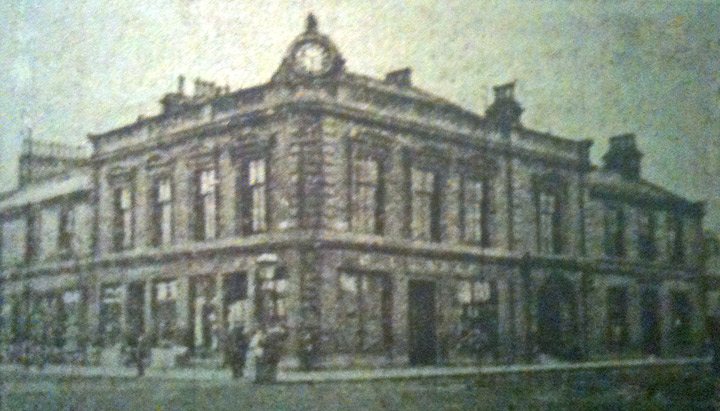
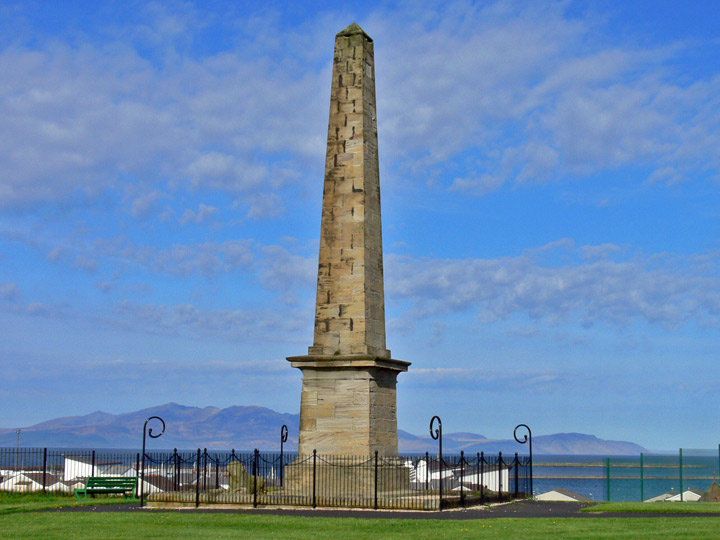
Ardrossan
and Saltcoats Herald, 30 October 1896
MINUTES OF ARDROSSAN TOWN
COUNCIL MEETINGS IN ITS EARLY YEARS
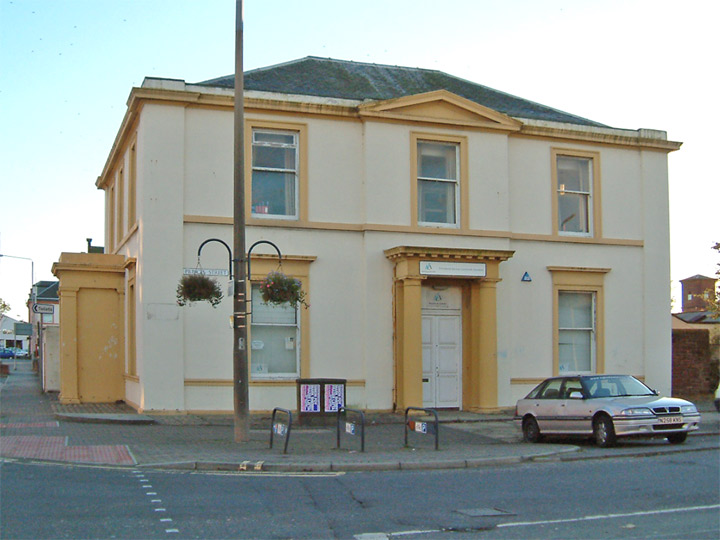 It
is interesting at this landmark in the history of the Burgh to recall the steps
taken by the first Council to organise its business and as showing the subjects
which engaged the attention of the 'Fathers' till 1858, when the foundation
stone was laid of the Townhouse, we give a few notes as gleaned from the Council's
minute book. The first minute in the Burgh records bears date 5 November 1846
when the newly-elected Councillors were sworn in by the Sheriff. On the day
following, there was a meeting when, as a matter of course, the appointment
of officials, committees, etc was the chief business transacted. Afterwards,
the Town Clerk was instructed to draw up a short memorial and queries in reference
to points connected with the Act and submit these to a Glasgow writer of some
standing for his opinion. John Gourlay, Gas Manager, was appointed Surveyor
of the Burgh and instructed to proceed forthwith 'to make up a rental of
the Burgh'. James Willock, Adam Barrie, Archibald Russell, Peter Barclay
and William Fullerton were appointed a Standing Committee. In addition to other
things, 'the Standing Committee were requested to survey the Burgh and ascertain
the state of the pavements, lanes and thoroughfares and to report the same to
next meeting'. Pavements then, as now, seem to have been a burning question.
Amongst the first acts the Commissioners performed was to take over the street
lighting and an offer from the Gas Company to light the street lamps, charging
at the rate of seven shillings per lamp was accepted. At a very early stage
also, the Burgh authorities insisted on kerb-stones being put down as 'boundaries
of pavements in lanes'. From minute of that meeting held on 7 December 1846,
it appears that the Clerk had issued notices to proprietors in terms of the
report of the Standing Committee. From subsequent minutes, it appears that one
proprietor refused compliance whereupon the Commissioners, after due exhortation
to which he appears to have paid no heed, had the work done at his expense.
The taxed accounts of the expenses connected with the procuring of the Burgh
Act appears in a minute of this period to have amounted to £1128 9s 5d.
To meet this, a loan was negotiated with the Bank of Scotland (whose Ardrossan
branch is shown right as the Community Education Office in 2003), Lord Eglinton
giving his personal obligation to the bond in addition to that of the Magistrates
and Council. At a meeting on 4 January 1847, 'the Clerk produced subscription
lists for building at courthouse and Town Hall and the meeting appointed the
Provost to wait upon Lord Eglinton with said list and to request his support
to the proposed scheme'. At the following meeting, the Clerk was instructed
to 'prepare lists of the proprietors with the rents of their properties,
showing the subscription payable by each, being one-fourth of a year's rent'
and at the meeting immediately following this one, the Clerk stated that the
gross amount of the rental was '£4214 14s and supposing each proprietor
were to subscribe a fourth of the year's rent, the sum of £1050 8s would
be raised in aid of the funds for building the proposed Town Hall and Courthouse'.
At a meeting held on 15 September 1847, 9d per £ was fixed as the rate
of assessment to be levied for the year from Whitsunday previous to Whitsunday
following. At the same meeting, Mr John Hogarth was appointed auditor of accounts.
At a meeting held on 11 May 1848, the Commissioners authorised the payment of
the first expenses incurred by them in the law courts which amounted to £11.
At a meeting held on 3 June of the same year, it was agreed to memorialise the
Belfast Chamber of Commerce in favour of a proposal to change the Mail Packet
stations from Portpatrick and Donaghadee to Belfast and Ardrossan.
It
is interesting at this landmark in the history of the Burgh to recall the steps
taken by the first Council to organise its business and as showing the subjects
which engaged the attention of the 'Fathers' till 1858, when the foundation
stone was laid of the Townhouse, we give a few notes as gleaned from the Council's
minute book. The first minute in the Burgh records bears date 5 November 1846
when the newly-elected Councillors were sworn in by the Sheriff. On the day
following, there was a meeting when, as a matter of course, the appointment
of officials, committees, etc was the chief business transacted. Afterwards,
the Town Clerk was instructed to draw up a short memorial and queries in reference
to points connected with the Act and submit these to a Glasgow writer of some
standing for his opinion. John Gourlay, Gas Manager, was appointed Surveyor
of the Burgh and instructed to proceed forthwith 'to make up a rental of
the Burgh'. James Willock, Adam Barrie, Archibald Russell, Peter Barclay
and William Fullerton were appointed a Standing Committee. In addition to other
things, 'the Standing Committee were requested to survey the Burgh and ascertain
the state of the pavements, lanes and thoroughfares and to report the same to
next meeting'. Pavements then, as now, seem to have been a burning question.
Amongst the first acts the Commissioners performed was to take over the street
lighting and an offer from the Gas Company to light the street lamps, charging
at the rate of seven shillings per lamp was accepted. At a very early stage
also, the Burgh authorities insisted on kerb-stones being put down as 'boundaries
of pavements in lanes'. From minute of that meeting held on 7 December 1846,
it appears that the Clerk had issued notices to proprietors in terms of the
report of the Standing Committee. From subsequent minutes, it appears that one
proprietor refused compliance whereupon the Commissioners, after due exhortation
to which he appears to have paid no heed, had the work done at his expense.
The taxed accounts of the expenses connected with the procuring of the Burgh
Act appears in a minute of this period to have amounted to £1128 9s 5d.
To meet this, a loan was negotiated with the Bank of Scotland (whose Ardrossan
branch is shown right as the Community Education Office in 2003), Lord Eglinton
giving his personal obligation to the bond in addition to that of the Magistrates
and Council. At a meeting on 4 January 1847, 'the Clerk produced subscription
lists for building at courthouse and Town Hall and the meeting appointed the
Provost to wait upon Lord Eglinton with said list and to request his support
to the proposed scheme'. At the following meeting, the Clerk was instructed
to 'prepare lists of the proprietors with the rents of their properties,
showing the subscription payable by each, being one-fourth of a year's rent'
and at the meeting immediately following this one, the Clerk stated that the
gross amount of the rental was '£4214 14s and supposing each proprietor
were to subscribe a fourth of the year's rent, the sum of £1050 8s would
be raised in aid of the funds for building the proposed Town Hall and Courthouse'.
At a meeting held on 15 September 1847, 9d per £ was fixed as the rate
of assessment to be levied for the year from Whitsunday previous to Whitsunday
following. At the same meeting, Mr John Hogarth was appointed auditor of accounts.
At a meeting held on 11 May 1848, the Commissioners authorised the payment of
the first expenses incurred by them in the law courts which amounted to £11.
At a meeting held on 3 June of the same year, it was agreed to memorialise the
Belfast Chamber of Commerce in favour of a proposal to change the Mail Packet
stations from Portpatrick and Donaghadee to Belfast and Ardrossan. 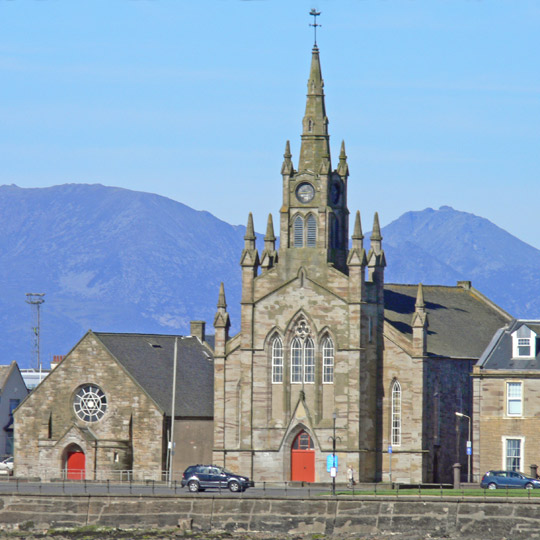 At
a meeting on 2 October 1848, the Clerk produced and read to the meeting a copy
of minutes of meeting of sub-commitee and subscribers to Ardrossan New Parish
Church (shown left as Barony Saint John's Church in 2009) from which it appeared
that, according to an agreement come to at a meeting in Saltcoats, a statement
was prepared 'showing the least amount of territory which would be required
for the new parish that would afford the stipend for the minister (128 6s 8d)
inclusive of the sum allowed for communion elements'. Mr Fullerton suggested
that, in order to do away with all opposition from the heritors and to save
delay and expenses, 'the proposed parish should be a Burghal parish which
proposal the Town Council could effect by granting a bond to the Court of Session
for the stipend and that Lord Eglinton could grant the necessary bond in favour
of the Town Council to relieve them of the stipend in all time coming'.
The report also bore that Lord Eglinton had agreed to grant the Bond of Relief
to the Town Council in the matter above-mentioned. The meeting did not come
to any decision on the report. The entry regarding the New Parish Church is
under date 27 November when Provost Barr moved that a meeting of electors be
called to consider if the Council should grant a bond for the minister's stipend.
The motion was agreed to. In the minutes of the meeting held on 14 June 1849,
appears the following entry. 'The Clerk read to the meeting a letter from
Mr Johnstone, Lord Eglinton's factor to Provost Barr in reference to the plot
of ground acquired by the Magistrates and Council from Mr A Russell.'. The
plot of ground referred to was that on which the Town Hall and offices are now
built. The letter recalled the Commissioners to the fact that nothing had been
done in the matter and requested the Commissioners to inform Lord Eglinton whether
they still adhered to their original intention or had abandoned it altogether.
As a result of this letter, it was agreed to instruct the Clerk to write to
Mr Johnstone requesting him to fix a day of meeting the purpose of getting the
plot of ground laid off. 'The meeting agreed that the plot of ground should
be forty-five feet.'. With reference to the Cannon Hill (shown below right
in 2006), the following entry appears in the minutes of the meeting held on
16 August 1849. 'Provost Barr stated that he had called the present meeting
in consequence of a conversation he had had with Lord Eglinton at which meeting
his lordship had stated his regret that the strangers in Ardrossan this summer
had been so few and expressed his willingness to make public walks about the
Cannon Hill and other places in the neighbourhood at his lordship's expense
provided the Commissioners agree to pay a rent to him for the Cannon Hill. The
meeting having taken the Provost's statement into consideration authorised him
to arrange with Lord Eglinton in reference to the matter in the best way he
could and to report to a future meeting.'. The history of the negotiations
preceding the handing over the Cannon Hill to the town are doubtless within
the knowledge of many of our local readers. Hugh Chalmers, tenant of Parkhouse,
offered to give up the hill on condition that he should retain a right of road
through it to his adjoining field and that he should receive the same rent as
he paid to Lord Eglinton with the addition of £3 per annum during the
remainder of his lease but he afterwards claimed that, in addition to the rent
of the curling pond and the right-of-way across the lower part of the park,
the sum to be paid to him should be settled by arbitration. The record runs
that 'The meeting authorised the Provost to meet with Mr Chalmers and arrange
with him.'.
At
a meeting on 2 October 1848, the Clerk produced and read to the meeting a copy
of minutes of meeting of sub-commitee and subscribers to Ardrossan New Parish
Church (shown left as Barony Saint John's Church in 2009) from which it appeared
that, according to an agreement come to at a meeting in Saltcoats, a statement
was prepared 'showing the least amount of territory which would be required
for the new parish that would afford the stipend for the minister (128 6s 8d)
inclusive of the sum allowed for communion elements'. Mr Fullerton suggested
that, in order to do away with all opposition from the heritors and to save
delay and expenses, 'the proposed parish should be a Burghal parish which
proposal the Town Council could effect by granting a bond to the Court of Session
for the stipend and that Lord Eglinton could grant the necessary bond in favour
of the Town Council to relieve them of the stipend in all time coming'.
The report also bore that Lord Eglinton had agreed to grant the Bond of Relief
to the Town Council in the matter above-mentioned. The meeting did not come
to any decision on the report. The entry regarding the New Parish Church is
under date 27 November when Provost Barr moved that a meeting of electors be
called to consider if the Council should grant a bond for the minister's stipend.
The motion was agreed to. In the minutes of the meeting held on 14 June 1849,
appears the following entry. 'The Clerk read to the meeting a letter from
Mr Johnstone, Lord Eglinton's factor to Provost Barr in reference to the plot
of ground acquired by the Magistrates and Council from Mr A Russell.'. The
plot of ground referred to was that on which the Town Hall and offices are now
built. The letter recalled the Commissioners to the fact that nothing had been
done in the matter and requested the Commissioners to inform Lord Eglinton whether
they still adhered to their original intention or had abandoned it altogether.
As a result of this letter, it was agreed to instruct the Clerk to write to
Mr Johnstone requesting him to fix a day of meeting the purpose of getting the
plot of ground laid off. 'The meeting agreed that the plot of ground should
be forty-five feet.'. With reference to the Cannon Hill (shown below right
in 2006), the following entry appears in the minutes of the meeting held on
16 August 1849. 'Provost Barr stated that he had called the present meeting
in consequence of a conversation he had had with Lord Eglinton at which meeting
his lordship had stated his regret that the strangers in Ardrossan this summer
had been so few and expressed his willingness to make public walks about the
Cannon Hill and other places in the neighbourhood at his lordship's expense
provided the Commissioners agree to pay a rent to him for the Cannon Hill. The
meeting having taken the Provost's statement into consideration authorised him
to arrange with Lord Eglinton in reference to the matter in the best way he
could and to report to a future meeting.'. The history of the negotiations
preceding the handing over the Cannon Hill to the town are doubtless within
the knowledge of many of our local readers. Hugh Chalmers, tenant of Parkhouse,
offered to give up the hill on condition that he should retain a right of road
through it to his adjoining field and that he should receive the same rent as
he paid to Lord Eglinton with the addition of £3 per annum during the
remainder of his lease but he afterwards claimed that, in addition to the rent
of the curling pond and the right-of-way across the lower part of the park,
the sum to be paid to him should be settled by arbitration. The record runs
that 'The meeting authorised the Provost to meet with Mr Chalmers and arrange
with him.'.  There
the matter appeared to have rested for some time. The principle of at least
partial prohibition in regard to licences seems to have been accepted by the
Commissioners. Under date 17 April 1850 occurs the following entry 'The Provost
proposed that he and certain other parties should visit the public houses within
the Burgh with a view, if possible, to diminish their number and restrict the
hours during which they should be kept open to which the meeting agreed.'.
What was done in the matter does not appear but in a subsequent minute it is
recorded the Provost brought under the notice of the Commissioners 'the propriety
of warning the innkeepers and other retailers of spirits and other liquors within
the Burgh' against supplying liquor to lunatics, one of whom is specially
mentioned by name, or persons under age. When the late Joseph McCulloch was
the only officer, it was the custom to call him in and request him to report
on the how the public houses were conducted. One of the functions of the Commissioners
which now belongs to the Magistrates appears in the following entry - the first
of the kind - under date 14 May 1850. 'It was stated to the meeting that
it had been called in consequence of a breach of the peace which had been committed
in the Burgh last night. After some discussion, the meeting agreed to watch
the proceedings of parties who may commit a breach of the peace tonight and
thereafter to take steps to get the special constables organised.' Concerning
what further happened, no record is left to posterity. About the same time,
complaint began to be made about the number of beggars in the Burgh. No notice
was taken of the matter until 8 January 1851 under which date the following
entry appears. 'The Clerk was instructed to answer said letter and to state
that under existing circumstances it was impossible to remedy the evil complained
of until lock-up houses be erected.' and in the meantime the Commissioners
hoped the writer of the letter would not press the matter. Rigorous orders against
trespassers on the 'public' walks on the Castle Hill were issued and a hint
was conveyed to the watchman in the following terms 'The Clerk was instructed
to inform the watchman that unless he reported trespassers, his services would
be dispensed with'. Further, 'The Committee of Commissioners were instructed
to shift the door into the Castle Hill from the Cannon Hill or to put up a fence
to said door and the Clerk was instructed to give notice by handbill that no-one
was to be allowed to dry or spread clothes on the Castle Hill or walks and that
all parties found trespassing on said walks would be prosecuted, the same notice
as to trespassing to be sent through Saltcoats.'. At a meeting held on 27
September 1858, offers for the erection of the proposed Town House were opened
and examined and the Clerk was instructed to send same to Mr Gairdner, Lord
Eglinton's factor, for his remarks previous to fixing upon the contractors.
The plans seem to have been considered satisfactory and on 30 October, the foundation
stone was laid with Masonic honours by George Johnstone esquire of Redburn,
Mr D C Love, G A, Ardrossan placing the coins of the realm and the usual documents
in the cavity which was afterwards covered with a brass plate bearing the following
inscription 'This stone laid on 30 October 1858 by the Mother Lodge of Free
Masons, Kilwinning. George Johnstone P G M, Hugh Conn D G M, Robert Boyd S G
M, Charles Breckenridge S P W, James Hendrie Past P W'. We need not quote
further from the minutes. In the minutes of 19 December 1850, appears the following
entry from which date the proceeding have been reported 'The Clerk read the
following letter from Mr Arthur Guthrie, publisher of the Ardrossan and Saltcoats
Herald. Representation having been made to me, as publisher as publisher of
the local paper that reports of the meetings of Town council would be acceptable.
I take the liberty of requesting permission for my reporter being present for
that purpose.'. The Clerk was instructed to intimate to Mr Guthrie that
the Commissioners had no objection to his attending the four statutory quarterly
meetings appointed to be held annually under the Act. This permission was later
extended to all monthly meetings. Until the death of Provost Barr in 1884, the
only important developments of the Burgh which we can recall after 1858 are
the formation of the artillery corps in 1859, the organisation of the United
Presbyterian Church in 1857, the Episcopal Church in 1873 and the acquisition
of the old Bute Place by the Glasgow and South West Railway Company for the
erection of their new offices in 1874. Like the New Parish Church, the Independent
Church and the Free Church were organised before the Burgh Act was passed, the
former in 1837 and the latter in 1844. For some years, there was something of
a stand-still and it was not until there was a talk of an extension of the harbour
and the introduction of a new railway that the breadth of a new life began to
be felt.
There
the matter appeared to have rested for some time. The principle of at least
partial prohibition in regard to licences seems to have been accepted by the
Commissioners. Under date 17 April 1850 occurs the following entry 'The Provost
proposed that he and certain other parties should visit the public houses within
the Burgh with a view, if possible, to diminish their number and restrict the
hours during which they should be kept open to which the meeting agreed.'.
What was done in the matter does not appear but in a subsequent minute it is
recorded the Provost brought under the notice of the Commissioners 'the propriety
of warning the innkeepers and other retailers of spirits and other liquors within
the Burgh' against supplying liquor to lunatics, one of whom is specially
mentioned by name, or persons under age. When the late Joseph McCulloch was
the only officer, it was the custom to call him in and request him to report
on the how the public houses were conducted. One of the functions of the Commissioners
which now belongs to the Magistrates appears in the following entry - the first
of the kind - under date 14 May 1850. 'It was stated to the meeting that
it had been called in consequence of a breach of the peace which had been committed
in the Burgh last night. After some discussion, the meeting agreed to watch
the proceedings of parties who may commit a breach of the peace tonight and
thereafter to take steps to get the special constables organised.' Concerning
what further happened, no record is left to posterity. About the same time,
complaint began to be made about the number of beggars in the Burgh. No notice
was taken of the matter until 8 January 1851 under which date the following
entry appears. 'The Clerk was instructed to answer said letter and to state
that under existing circumstances it was impossible to remedy the evil complained
of until lock-up houses be erected.' and in the meantime the Commissioners
hoped the writer of the letter would not press the matter. Rigorous orders against
trespassers on the 'public' walks on the Castle Hill were issued and a hint
was conveyed to the watchman in the following terms 'The Clerk was instructed
to inform the watchman that unless he reported trespassers, his services would
be dispensed with'. Further, 'The Committee of Commissioners were instructed
to shift the door into the Castle Hill from the Cannon Hill or to put up a fence
to said door and the Clerk was instructed to give notice by handbill that no-one
was to be allowed to dry or spread clothes on the Castle Hill or walks and that
all parties found trespassing on said walks would be prosecuted, the same notice
as to trespassing to be sent through Saltcoats.'. At a meeting held on 27
September 1858, offers for the erection of the proposed Town House were opened
and examined and the Clerk was instructed to send same to Mr Gairdner, Lord
Eglinton's factor, for his remarks previous to fixing upon the contractors.
The plans seem to have been considered satisfactory and on 30 October, the foundation
stone was laid with Masonic honours by George Johnstone esquire of Redburn,
Mr D C Love, G A, Ardrossan placing the coins of the realm and the usual documents
in the cavity which was afterwards covered with a brass plate bearing the following
inscription 'This stone laid on 30 October 1858 by the Mother Lodge of Free
Masons, Kilwinning. George Johnstone P G M, Hugh Conn D G M, Robert Boyd S G
M, Charles Breckenridge S P W, James Hendrie Past P W'. We need not quote
further from the minutes. In the minutes of 19 December 1850, appears the following
entry from which date the proceeding have been reported 'The Clerk read the
following letter from Mr Arthur Guthrie, publisher of the Ardrossan and Saltcoats
Herald. Representation having been made to me, as publisher as publisher of
the local paper that reports of the meetings of Town council would be acceptable.
I take the liberty of requesting permission for my reporter being present for
that purpose.'. The Clerk was instructed to intimate to Mr Guthrie that
the Commissioners had no objection to his attending the four statutory quarterly
meetings appointed to be held annually under the Act. This permission was later
extended to all monthly meetings. Until the death of Provost Barr in 1884, the
only important developments of the Burgh which we can recall after 1858 are
the formation of the artillery corps in 1859, the organisation of the United
Presbyterian Church in 1857, the Episcopal Church in 1873 and the acquisition
of the old Bute Place by the Glasgow and South West Railway Company for the
erection of their new offices in 1874. Like the New Parish Church, the Independent
Church and the Free Church were organised before the Burgh Act was passed, the
former in 1837 and the latter in 1844. For some years, there was something of
a stand-still and it was not until there was a talk of an extension of the harbour
and the introduction of a new railway that the breadth of a new life began to
be felt.
Ardrossan
and Saltcoats Herald, 30 October 1896
JOHN BARR - ARDROSSAN'S FIRST
PROVOST
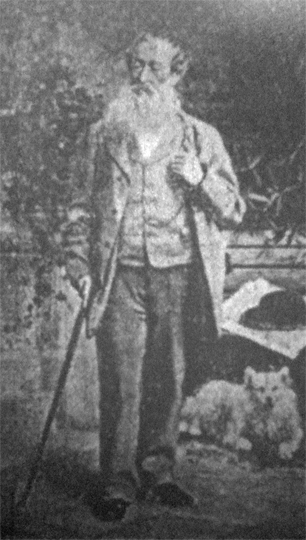 The
choice of John Barr (shown right in 1878) as Provost was a happy one, Born in
Lochwinnoch in 1798, he was a self-made man and one other illustration of the
kind of men who at the beginning of this century were reared under a weaver's
roof and inherited from worthy parents that grit and strength of character which
has made healthy Scotchmen famous all over the world. Leaving the loom on which
he worked as a boy, he became a contractor and it was the railway hence to Kilwinning
which brought him to Ardrossan in the year 1828. He afterwards contracted the
deepening of the old harbour and the building of the sea-wall in front of Montgomerie
Street, the space intervening once a green esplanade now covered with lines
of rails, being filled in by the soil taken out of the harbour. In 1842, in
company with the late James Shearer, he entered on the business of shipbuilding.
In association with Mr Shearer, he thus became a large employer of labour for
shipbuilding flourished and with the development of that and other branches
of industry such as the Engineering Works if Provost Young, the Foundry of the
Messrs Goodwin and the 'wee yaird' of Mr Peter Barclay, the population of the
town rapidly increased. To such an extent did Provost Barr meet the demands
for shop and house accommodation that possibly at one time one-fifth of the
town, if not more, belonged to him. He was a Justice of the Peace, chairman
for many years of the Gas and Water Company of which he was an active promoter,
first Chairman of the School Board and a trustee of the New Parish Church. To
be Provost of the Burgh for thirty-eight years was in itself a striking testimony
of the high estimate placed upon his value as a citizen. His life and the life
of the town has been closely interwoven during these years. In a very true sense,
he was one of its 'Makers' and pleasing evidence of the general recognition
of this fact was furnished when in 1878, he was presented with his portrait,
painted by Norman Macbeth, ARS, and which now hangs in the Town Hall, the presentation
being made by Sir James Fergusson at a meeting presided over by the Earl of
Eglinton.
The
choice of John Barr (shown right in 1878) as Provost was a happy one, Born in
Lochwinnoch in 1798, he was a self-made man and one other illustration of the
kind of men who at the beginning of this century were reared under a weaver's
roof and inherited from worthy parents that grit and strength of character which
has made healthy Scotchmen famous all over the world. Leaving the loom on which
he worked as a boy, he became a contractor and it was the railway hence to Kilwinning
which brought him to Ardrossan in the year 1828. He afterwards contracted the
deepening of the old harbour and the building of the sea-wall in front of Montgomerie
Street, the space intervening once a green esplanade now covered with lines
of rails, being filled in by the soil taken out of the harbour. In 1842, in
company with the late James Shearer, he entered on the business of shipbuilding.
In association with Mr Shearer, he thus became a large employer of labour for
shipbuilding flourished and with the development of that and other branches
of industry such as the Engineering Works if Provost Young, the Foundry of the
Messrs Goodwin and the 'wee yaird' of Mr Peter Barclay, the population of the
town rapidly increased. To such an extent did Provost Barr meet the demands
for shop and house accommodation that possibly at one time one-fifth of the
town, if not more, belonged to him. He was a Justice of the Peace, chairman
for many years of the Gas and Water Company of which he was an active promoter,
first Chairman of the School Board and a trustee of the New Parish Church. To
be Provost of the Burgh for thirty-eight years was in itself a striking testimony
of the high estimate placed upon his value as a citizen. His life and the life
of the town has been closely interwoven during these years. In a very true sense,
he was one of its 'Makers' and pleasing evidence of the general recognition
of this fact was furnished when in 1878, he was presented with his portrait,
painted by Norman Macbeth, ARS, and which now hangs in the Town Hall, the presentation
being made by Sir James Fergusson at a meeting presided over by the Earl of
Eglinton.
Ardrossan
and Saltcoats Herald, 30 October 1896
JOHN HOGARTH - ARDROSSAN'S
SECOND PROVOST
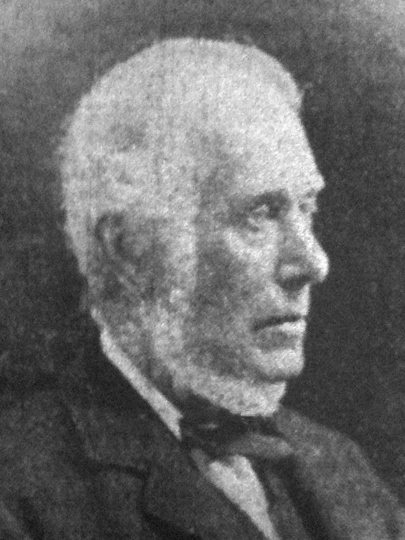 John
Hogarth, (shown left around the 1870s), who had been elected to the Town Council
in 1851, had been treasurer from 1852 to 1858 and Bailie from 1859, succeeded
to the Provostship on the death of Provost Barr in 1884. A native of Stevenston,
in early life he was apprenticed to Messrs Fullerton, ironmongers, Saltcoats
and in 1842, represented them in Ardrossan. After being a short time in Glasgow,
he returned to Ardrossan as partner with the late William Fullerton who retired
in 1851, the year Mr Hogarth entered the Town Council. His election to the office
of Chief magistrate was at a time when his intimate knowledge of every department
of the town's affairs was invaluable. In 1884, the Lanarkshire and Ayrshire
Railway Act was passed and four years later was opened for traffic. At the same
time, a Bill was passed for the extension of the harbour under a company which
was completed and opened in 1892. The gas and water supply which had been in
the hands of an amalgamated company from 1874 and of which the Provost had been
a director and latterly chairman, was in 1886 purchased by the town. In 1882,
he was added to the Commissioners of the Peace. In 1883, he represented the
Burgh on the Irvine District Roads Board. In 1885, he was enrolled a Commissioner
of Supply and in 1888 was elected a member of the County Roads Board. The experience
thus acquired was of great service when, as representative of Ardrossan on the
County Council, he succeeded in getting the roads, which had been taken over
by that authority in 1891, placed under the management of the Town Council.
It is no small matter to give forty-years service to the public and ex-Provost
Hogarth's term of office is not only memorable because embracing some of the
most progressive events in the history of the Burgh, but for the practical sagacity
and the wide experience and ability which he brought to bear on the business.
He was in office when the breath of new life referred to was beginning to be
felt and he worthily represented the Burgh before Parliamentary Committee and
at the inauguration of the extension of the harbour and the opening of the new
railway.
John
Hogarth, (shown left around the 1870s), who had been elected to the Town Council
in 1851, had been treasurer from 1852 to 1858 and Bailie from 1859, succeeded
to the Provostship on the death of Provost Barr in 1884. A native of Stevenston,
in early life he was apprenticed to Messrs Fullerton, ironmongers, Saltcoats
and in 1842, represented them in Ardrossan. After being a short time in Glasgow,
he returned to Ardrossan as partner with the late William Fullerton who retired
in 1851, the year Mr Hogarth entered the Town Council. His election to the office
of Chief magistrate was at a time when his intimate knowledge of every department
of the town's affairs was invaluable. In 1884, the Lanarkshire and Ayrshire
Railway Act was passed and four years later was opened for traffic. At the same
time, a Bill was passed for the extension of the harbour under a company which
was completed and opened in 1892. The gas and water supply which had been in
the hands of an amalgamated company from 1874 and of which the Provost had been
a director and latterly chairman, was in 1886 purchased by the town. In 1882,
he was added to the Commissioners of the Peace. In 1883, he represented the
Burgh on the Irvine District Roads Board. In 1885, he was enrolled a Commissioner
of Supply and in 1888 was elected a member of the County Roads Board. The experience
thus acquired was of great service when, as representative of Ardrossan on the
County Council, he succeeded in getting the roads, which had been taken over
by that authority in 1891, placed under the management of the Town Council.
It is no small matter to give forty-years service to the public and ex-Provost
Hogarth's term of office is not only memorable because embracing some of the
most progressive events in the history of the Burgh, but for the practical sagacity
and the wide experience and ability which he brought to bear on the business.
He was in office when the breath of new life referred to was beginning to be
felt and he worthily represented the Burgh before Parliamentary Committee and
at the inauguration of the extension of the harbour and the opening of the new
railway.
Ardrossan
and Saltcoats Herald, 30 October 1896
WILLIAM YOUNG - ARDROSSAN'S
THIRD PROVOST
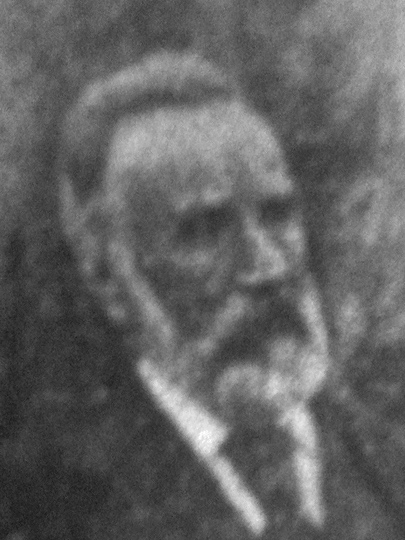 On
the retiral of Provost Hogarth in 1893, the choice of the Commissioners fell
upon Mr William Young (shown left around the 1880s). A native of Cupar, Fifeshire,
he came to Ardrossan as far back as 1856 to take charge of the engineering department
of the harbour under the late Mr John Moffat and form 1865 has managed a large
engineering business on his own account. He was first elected to the Council
Board under the old Act but was only a few months in office. He entered the
Council again in 1887 when his practical ability could be turned to good account.
The Gas and Water had been acquired by the town and great improvements were
begun of contemplated. Within Provost Young's term of service as Councillor
and Provost, the new reservoir was made, two new filters introduced, the drainage
of the town improved by the old built drains being replaced by pipe drains,
the bucket system of daily cleansing adopted which has done much for the sanitary
welfare of the town and at his recommendation, a reconstruction of the Gas Works
by adapting it for the oil enrichment process with the result that the cost
of gas to the consumers has been reduced from 4s 2d to 3s 4d for 1000 feet.
At the present time, new crossings are being laid and the pavement question,
however it may be settled, is certain to result in a greatly improved town.
Provost Young is a Justice of the Peace and represents Ardrossan on the Technical
Education Committee of the County Council. It was also due to his initiative
that the grant-in-aid for these two years past has been devoted by the Commission
to the promotion of Technical Education classes.
On
the retiral of Provost Hogarth in 1893, the choice of the Commissioners fell
upon Mr William Young (shown left around the 1880s). A native of Cupar, Fifeshire,
he came to Ardrossan as far back as 1856 to take charge of the engineering department
of the harbour under the late Mr John Moffat and form 1865 has managed a large
engineering business on his own account. He was first elected to the Council
Board under the old Act but was only a few months in office. He entered the
Council again in 1887 when his practical ability could be turned to good account.
The Gas and Water had been acquired by the town and great improvements were
begun of contemplated. Within Provost Young's term of service as Councillor
and Provost, the new reservoir was made, two new filters introduced, the drainage
of the town improved by the old built drains being replaced by pipe drains,
the bucket system of daily cleansing adopted which has done much for the sanitary
welfare of the town and at his recommendation, a reconstruction of the Gas Works
by adapting it for the oil enrichment process with the result that the cost
of gas to the consumers has been reduced from 4s 2d to 3s 4d for 1000 feet.
At the present time, new crossings are being laid and the pavement question,
however it may be settled, is certain to result in a greatly improved town.
Provost Young is a Justice of the Peace and represents Ardrossan on the Technical
Education Committee of the County Council. It was also due to his initiative
that the grant-in-aid for these two years past has been devoted by the Commission
to the promotion of Technical Education classes.
Ardrossan
and Saltcoats Herald, 30 October 1896
ONLY THREE PROVOSTS AND TWO
TOWN CLERKS IN FIFTY YEARS
It is doubtless due to the length of Provost Barr's term of office that there
have been only three Provosts during the fifty years of the history of the Burgh
but it is notable that there have been only two Town Clerks in business - Mr
James O Mack already mentioned and Mr James Cook who was associated with Mr
Mack and subsequently received the appointment . The office of Procurator Fiscal
was first held by Mr Thomas Kirkhope then in 1863 by Mr Alexander Emslie and
on his death in 1865 the office was conferred on Mr John Emslie at the time
Collector for the Burgh in succession to Mr Alexander Young. The Burgh Collector
is now Mr John Adams.
Ardrossan
and Saltcoats Herald, 30 October 1896
ARDROSSAN TOWN COUNCILLORS
FROM 1846 TO 1896
List of Members of Ardrossan Town Council from passing of Burgh Act in 1846
till 1896
John Barr 1846-83
James Willock 1846-69
William Fullerton 1846-51, 1853-56
Adam Barrie 1846-49
Peter Barclay 1846-48
William Ford junior 1846-51
Archibald Russell 1846-47, 1850-53
John King 1846-47
James Shearer 1846-65
Robert Templeton 1847-50
Alexander Bain 1847-53
Robert Drape 1848-51, 1853-59, 1861-64
Robert Young 1849-52
Robert Crawford 1851- 57
David Barrie 1851-1860, 1863-65
John Hogarth 1851-1892
James Tyre 1852-60
John Jackson 1856-59
Archibald Currie 1857-78
Archibald Steel 1859-61
William Duncan 1859-62, 1863-64
William Gibson 1860-1866
Duncan Stewart 1860-62
John Smith 1860-71
Joseph Russell 1862 resigned
Thomas Gilfillan 1864-1891
John Boyd, builder 1865-90
Lewis Fullarton 1865-71, 1872-77
James Goodwin 1865-75
Thomas Wallace 1866-72, 1875-76
John Logan 1871-75
Athur Guthrie 1872-75
John Craig 1875-1890
J McLean 1876-78
William Young 1877, 1887-92
John Boyd, shoemaker 1878-86, 1887-89, 1895-96
John Anderson 1878-81, 1890-96
R Dunwoodie 1878-91
James Goodwin 1878 died
Peter McCarroll 1879-85, 1892-95
Alexander McMillan 1881-87
Thomas Kirkhope 1884-87, 1891-96
George Barrie 1885-90, 1891-96
James Harvey 1886-91
Archibald Gray junior 1890-96
Henry Wallace 1891-94
William Walls 1892-94
John Harvey 1894-96
F A P Bennett 1894-96
William Smith 1895-96
Ardrossan
and Saltcoats Herald, 30 October 1896
NOTEWORTHY EVENTS OF THE PAST
FIFTY YEARS IN ARDROSSAN
The growth of the municipality, as indicated in the Burgh records, is very interesting.
What an odd comparison may be instituted, for instance, between the Post Office
as we know it today and the conditions under which postal work was carried on
in 1859 when we perceived that on 28 December of that year, it was resolved
to memorialise the Treasury to have a stamp distributor appointed in Ardrossan.
Till then, stamp distributing was confined to Saltcoats. Civic
rulers of those days occasionally manifested a spirit which would seem to have
been engendered by anticipation of the important developments the Burgh was
destined to undergo. In the minutes of an early meeting occurs the following
entry 'The Clerk read a letter he had received form Mr John McMurtrie, writer
in Ayr, wishing payment of the fees payable to the Sheriff and Sheriff Clerks
attending the first election of Councillors of the Burgh. The meeting instructed
the Clerk to acknowledge receipt of said letter and to inform Mr McMurtrie that
they would settle their accounts in their own way and would not be guided by
him in such matters as they did not recognise him as their agent.'. It is soothing
to learn further that 'The meeting authorised Clerk, in the meantime to remit
the Sheriff and Sheriff Clerk's fees.'. Some
curious claims fell to be considered by the Commissioners. At a meeting thirty-five
years ago (in 1862), the Clerk read a claim of £4 by a boat-owner for
a boat burned by some persons on Lord Eglinton's birth night. The Commissioners
did not choose to entertain the claim, however, but requested the claimant to
formulate a charge against an individual and entrust the matter to the Fiscal.
THE FUTURE OF ARDROSSAN
A correspondent, JM, referring to the jubilee asks the question 'How is Ardrossan
to flourish in the future even more than she has done in the past?' Government
aid in the construction of graving docks on the Clyde has been much talked of
during the past year. To my mind, Ardrossan is the best point on the lower reaches
of the river for the construction of a graving dock large enough to admit war
vessels. It is quite certain that the harbour system will never be complete
without one. It is more that a pity that the Burgh of Ardrossan has no tangible
interest in the harbour. Even although the ratepayers were liable to be taxed
for harbour purposes, in cases of emergency, it would be preferable to have
a harbour run by people who are virtually outsiders. The same correspondent
has something to say regarding the union of the two Burghs. 'Ardrossan and Saltcoats
are geographically one and ought to be under one control. It is a great pity
that the sensible people of both towns do not 'reason together' on this important
subject. Unity is strength and the union of the towns would conduce to general
prosperity.'.
Ardrossan
and Saltcoats Herald, 30 October 1896
ARDROSSAN IN 1946
by A. Optimist
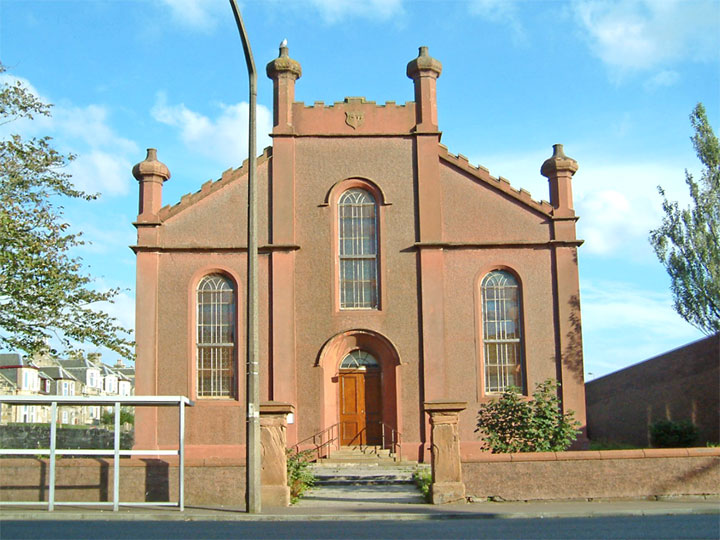 It
was on a lovely afternoon of July 1896 that I set sail from Ardrossan in the
good ship Peeweep for New York. My father was the captain of the vessel and
very proud was I, at the age of ten, to take this my first voyage with him.
In fact, we voyaged en famille for it had been determined to set up house on
the other side of the Atlantic. My career in the new country, I need not recount.
Enough that, having secured a comfortable competency for life, I now find myself
once again in Ardrossan in this year of grace, 1946. Fifty years have come and
gone since the Peeweep dropped down by Arran that summer day in the end of the
nineteenth century and I cannot tell you how often in the interval I was beset
with a deep longing to revisit the little town on the Ayrshire coast where the
dry winds were always piping and the railway engines always shunting. Gradually,
my resolve grew more definitive, that in my declining years I would settle down
in Ardrossan and here is my ambition realised. They tell me it is now exactly
a century since Ardrossan was constituted a Burgh with a town council , a provost
and bailies. Foraging, by the editor's kind permission, in the files of the
Ardrossan and Saltcoats Herald, I came the other day on a sketch of the town's
progress, published on the occasion of the municipal jubilee. Now that the centenary
has come round, I fall involuntarily into a comparison of what the place is
now in contrast to what it was in my boyhood's days. Glasgow Street, of which
I have a dreary memory as of a long unlovely street, is today of the same length
and breadth and is made up, for the most part, of the same houses as formerly
but a number of improvements have been carried out with the result that the
street is now a handsome and beautiful thoroughfare. The surface which used
to be macadamised like a turnpike road, is now causewayed with smooth close-fitting
stones. The pavements are of uniform breadth and material and in the best of
repair. A line of trees on either side has, in spite of the gale that still
may sweep the street, grown into tolerable height and foliage and suggests a
delightful boulevard air. At night, when it is lit, like the entire town, with
the electric light, it presents the appearance of an illuminated vista. The
gas works, for gas is not likely to be superseded, no longer stands in Glasgow
Street, having been removed to the outskirts. The long high red wall that used
to stand with prison-like aspect below the United Presbyterian Church (shown
right as the Church of the Nazarene in 2002) has disappeared and you look instead
clean away up to the Cannon Hill. The trees which were planted around the United
Presbyterian Church just before I left the town have grown up into surprising
luxuriance. Several new handsome building now enhance the street. Certain old
houses, near what used to be the Infant's School, have been taken down and on
their site stands the Free Public Library and Reading Room which a number of
generous citizens united in bestowing on the community. At the top of the street,
opposite the school, a fountain of wrought-iron plays while at the Princes Street
end, there is a statue to the good Queen Victoria of blessed memory. The public
houses have disappeared but in some four or five street, there is a large airy
restaurant managed on a modification of the Scandinavian system. In some of
these places of refreshment no alcoholic beverages can be obtained while in
others there is no restriction but in these latter, the liquor sold is certified
free form adulteration, The officials are well-paid, responsible men whose interest
it is to encourage temperance and I must confess that one does not nowadays
see a drunken man with a fraction of the frequency of my young days. In Princes
Street, there are new municipal buildings of imposing architecture with a spacious
hall for public meetings and entertainments and they tell me much more interest
is now taken in municipal elections, the Commissioners' Board being composed
of the ablest and most reputable citizens. Opposite the Police Station stand
the Public Baths with salt and fresh water where the poorest may perform weekly
or daily ablutions and attached to the Baths are a gymnasium and recreation
hall. The lanes of the town are things of the past. Quarry Lane (shown below
upper right as disused ground around the 1930s) has disappeared and others have
been renovated beyond recognition.
It
was on a lovely afternoon of July 1896 that I set sail from Ardrossan in the
good ship Peeweep for New York. My father was the captain of the vessel and
very proud was I, at the age of ten, to take this my first voyage with him.
In fact, we voyaged en famille for it had been determined to set up house on
the other side of the Atlantic. My career in the new country, I need not recount.
Enough that, having secured a comfortable competency for life, I now find myself
once again in Ardrossan in this year of grace, 1946. Fifty years have come and
gone since the Peeweep dropped down by Arran that summer day in the end of the
nineteenth century and I cannot tell you how often in the interval I was beset
with a deep longing to revisit the little town on the Ayrshire coast where the
dry winds were always piping and the railway engines always shunting. Gradually,
my resolve grew more definitive, that in my declining years I would settle down
in Ardrossan and here is my ambition realised. They tell me it is now exactly
a century since Ardrossan was constituted a Burgh with a town council , a provost
and bailies. Foraging, by the editor's kind permission, in the files of the
Ardrossan and Saltcoats Herald, I came the other day on a sketch of the town's
progress, published on the occasion of the municipal jubilee. Now that the centenary
has come round, I fall involuntarily into a comparison of what the place is
now in contrast to what it was in my boyhood's days. Glasgow Street, of which
I have a dreary memory as of a long unlovely street, is today of the same length
and breadth and is made up, for the most part, of the same houses as formerly
but a number of improvements have been carried out with the result that the
street is now a handsome and beautiful thoroughfare. The surface which used
to be macadamised like a turnpike road, is now causewayed with smooth close-fitting
stones. The pavements are of uniform breadth and material and in the best of
repair. A line of trees on either side has, in spite of the gale that still
may sweep the street, grown into tolerable height and foliage and suggests a
delightful boulevard air. At night, when it is lit, like the entire town, with
the electric light, it presents the appearance of an illuminated vista. The
gas works, for gas is not likely to be superseded, no longer stands in Glasgow
Street, having been removed to the outskirts. The long high red wall that used
to stand with prison-like aspect below the United Presbyterian Church (shown
right as the Church of the Nazarene in 2002) has disappeared and you look instead
clean away up to the Cannon Hill. The trees which were planted around the United
Presbyterian Church just before I left the town have grown up into surprising
luxuriance. Several new handsome building now enhance the street. Certain old
houses, near what used to be the Infant's School, have been taken down and on
their site stands the Free Public Library and Reading Room which a number of
generous citizens united in bestowing on the community. At the top of the street,
opposite the school, a fountain of wrought-iron plays while at the Princes Street
end, there is a statue to the good Queen Victoria of blessed memory. The public
houses have disappeared but in some four or five street, there is a large airy
restaurant managed on a modification of the Scandinavian system. In some of
these places of refreshment no alcoholic beverages can be obtained while in
others there is no restriction but in these latter, the liquor sold is certified
free form adulteration, The officials are well-paid, responsible men whose interest
it is to encourage temperance and I must confess that one does not nowadays
see a drunken man with a fraction of the frequency of my young days. In Princes
Street, there are new municipal buildings of imposing architecture with a spacious
hall for public meetings and entertainments and they tell me much more interest
is now taken in municipal elections, the Commissioners' Board being composed
of the ablest and most reputable citizens. Opposite the Police Station stand
the Public Baths with salt and fresh water where the poorest may perform weekly
or daily ablutions and attached to the Baths are a gymnasium and recreation
hall. The lanes of the town are things of the past. Quarry Lane (shown below
upper right as disused ground around the 1930s) has disappeared and others have
been renovated beyond recognition. 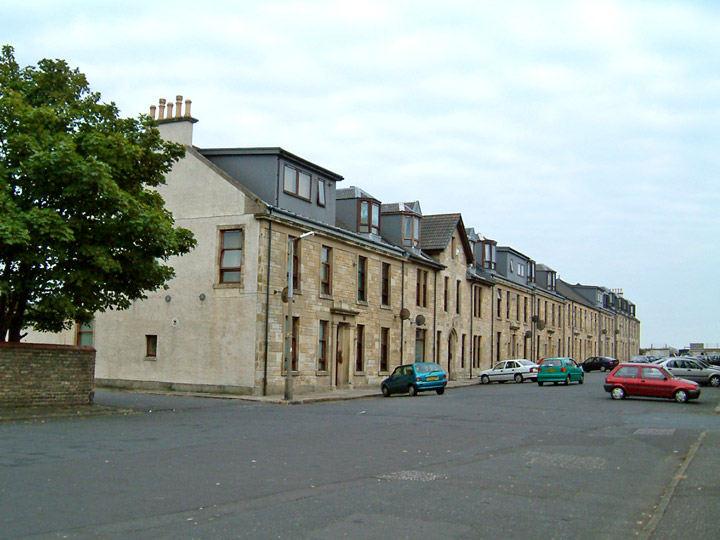 The
classes that used to crowd the lanes now live in streets like Winton Street
(shown right in 2002) which now extends to South Beach Station (shown below
upper centre in 1986) or Seton Street and Park Road (shown below upper right
in 2002) which have greatly extended while numbers who, in my early days, would
have resided in these streets now occupy tidy cottages toward the north end
of the town. Eglinton Street exhibits an unbroken row of cottages as far as
Seafield while behind that row, another runs parallel. In each row, there is
a pleasing variety of style of buildings - some of red, some of yellow, some
of whiter sandstone. What used to be the high road to Saltcoats from the head
of Glasgow Street round by the Hospital is now a continuation of cottages and
villas, the Hospital having been removed further inland and being much more
in use for all kinds of infectious cases than formerly. I was surprised to find
that the Cemetery had not extended since my departure but I learned the explanation
when, close beside it and edifice of sober, pleasing architecture was pointed
out to me as the crematorium. Some fields in the neighbourhood of the Cemetery
have been rented as a golf course, the presence of which has increased the attractiveness
of our town as a seaside resort. The same result is augmented by the fact of
the grassy Esplanade railed off from the Caledonian line at the North Crescent
and by the reclamation of ground at the South Beach where what used to be sandy
beach is now a green recreation ground defended from the encroachment of the
waves by a solid wall. On both these promenades stands a picturesque shelter
for the band, the town now possessing a Burgh orchestra which performs frequently
in the open air in summer and in the public hall in the winter. This band is
made up of mechanics and tradesmen who are encouraged to the acquirement of
musical ability by a subsidy disbursed from the town's exchequer. Montgomerie
Street has been improved by a well-chisled stone wall mounted with an iron railing
in good design with shrubs for a background, shutting off from the view of foot-passengers
the waggons that still shunt up and down. There is no smoke now, steam having
been replaced by electricity. On the notice board of the Free Church, as on
that of the United Presbyterian and Established Church, I observed the legend
'Church of Scotland' reminding me how, in my absence, the divisions of Presbyterianism
had been healed and the church reconstructed on a purely spiritual basis and
indeed I remember the excitement and enthusiasm throughout the old country when
it was published abroad that the Established Church had, by unanimous action
of its General Assembly, renounced its secular connection with the State and
the concomitant emoluments in the interest of a reunited Presbyterianism and
how the country, through its Parliament, insisted on the church retaining these
sources of revenue so long consecrated to religious use. Looking
out on the Firth from the Caledonian Bridge, one notices vast changes in the
outline of the harbour. The old breakwater has disappeared and instead a wall
of a similar kind stretches from the Horse Island to the rocks that run out
from Burnfoot, thus forming a kind of lagoon which has been dredged and rendered
deep enough to accommodate large vessels. The sudden increase of the prosperity
of the town dates from the period when this change was carried out, Ardrossan
being now one of the most thriving shipping places of the west. The large house
which at one time was the residence of Provost Barr and which I remember as
the Caledonian Hotel (shown below lower left as the disused Burgh Chambers in
1976) has been purchased by the School Board and converted into and infant school.
The grounds are once more nicely laid out and are an adornment to the street.
The spirit of memory is upon me as I wander up the Castle Hill, there to sit
down and overlook the town and all its changes. The seat which I choose is one
within view of three imposing bronze statues. One of the figures is warrior-like,
the outstretched sword pointing to the ruins of Ardrossan Castle (shown below
lower right in the early 1900s). Of the second, the face is rugged but noble
as he stands there with his Geneva gown. Of the third, the subject is meditative,
the hand shading the eyes that gaze away towards auld Ayr. The one is Wallace,
the second Knox and the third Burns. After fifty years, I do not find that my
country men have lost their patriotism, their religion or their sentiment.
The
classes that used to crowd the lanes now live in streets like Winton Street
(shown right in 2002) which now extends to South Beach Station (shown below
upper centre in 1986) or Seton Street and Park Road (shown below upper right
in 2002) which have greatly extended while numbers who, in my early days, would
have resided in these streets now occupy tidy cottages toward the north end
of the town. Eglinton Street exhibits an unbroken row of cottages as far as
Seafield while behind that row, another runs parallel. In each row, there is
a pleasing variety of style of buildings - some of red, some of yellow, some
of whiter sandstone. What used to be the high road to Saltcoats from the head
of Glasgow Street round by the Hospital is now a continuation of cottages and
villas, the Hospital having been removed further inland and being much more
in use for all kinds of infectious cases than formerly. I was surprised to find
that the Cemetery had not extended since my departure but I learned the explanation
when, close beside it and edifice of sober, pleasing architecture was pointed
out to me as the crematorium. Some fields in the neighbourhood of the Cemetery
have been rented as a golf course, the presence of which has increased the attractiveness
of our town as a seaside resort. The same result is augmented by the fact of
the grassy Esplanade railed off from the Caledonian line at the North Crescent
and by the reclamation of ground at the South Beach where what used to be sandy
beach is now a green recreation ground defended from the encroachment of the
waves by a solid wall. On both these promenades stands a picturesque shelter
for the band, the town now possessing a Burgh orchestra which performs frequently
in the open air in summer and in the public hall in the winter. This band is
made up of mechanics and tradesmen who are encouraged to the acquirement of
musical ability by a subsidy disbursed from the town's exchequer. Montgomerie
Street has been improved by a well-chisled stone wall mounted with an iron railing
in good design with shrubs for a background, shutting off from the view of foot-passengers
the waggons that still shunt up and down. There is no smoke now, steam having
been replaced by electricity. On the notice board of the Free Church, as on
that of the United Presbyterian and Established Church, I observed the legend
'Church of Scotland' reminding me how, in my absence, the divisions of Presbyterianism
had been healed and the church reconstructed on a purely spiritual basis and
indeed I remember the excitement and enthusiasm throughout the old country when
it was published abroad that the Established Church had, by unanimous action
of its General Assembly, renounced its secular connection with the State and
the concomitant emoluments in the interest of a reunited Presbyterianism and
how the country, through its Parliament, insisted on the church retaining these
sources of revenue so long consecrated to religious use. Looking
out on the Firth from the Caledonian Bridge, one notices vast changes in the
outline of the harbour. The old breakwater has disappeared and instead a wall
of a similar kind stretches from the Horse Island to the rocks that run out
from Burnfoot, thus forming a kind of lagoon which has been dredged and rendered
deep enough to accommodate large vessels. The sudden increase of the prosperity
of the town dates from the period when this change was carried out, Ardrossan
being now one of the most thriving shipping places of the west. The large house
which at one time was the residence of Provost Barr and which I remember as
the Caledonian Hotel (shown below lower left as the disused Burgh Chambers in
1976) has been purchased by the School Board and converted into and infant school.
The grounds are once more nicely laid out and are an adornment to the street.
The spirit of memory is upon me as I wander up the Castle Hill, there to sit
down and overlook the town and all its changes. The seat which I choose is one
within view of three imposing bronze statues. One of the figures is warrior-like,
the outstretched sword pointing to the ruins of Ardrossan Castle (shown below
lower right in the early 1900s). Of the second, the face is rugged but noble
as he stands there with his Geneva gown. Of the third, the subject is meditative,
the hand shading the eyes that gaze away towards auld Ayr. The one is Wallace,
the second Knox and the third Burns. After fifty years, I do not find that my
country men have lost their patriotism, their religion or their sentiment.
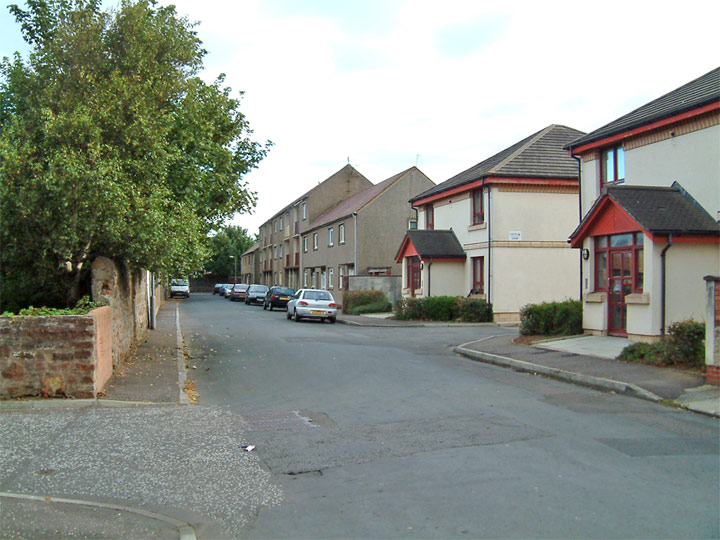
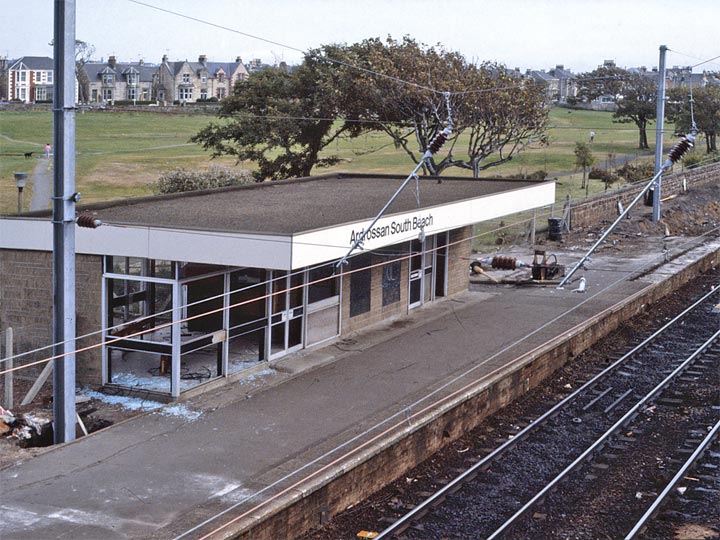
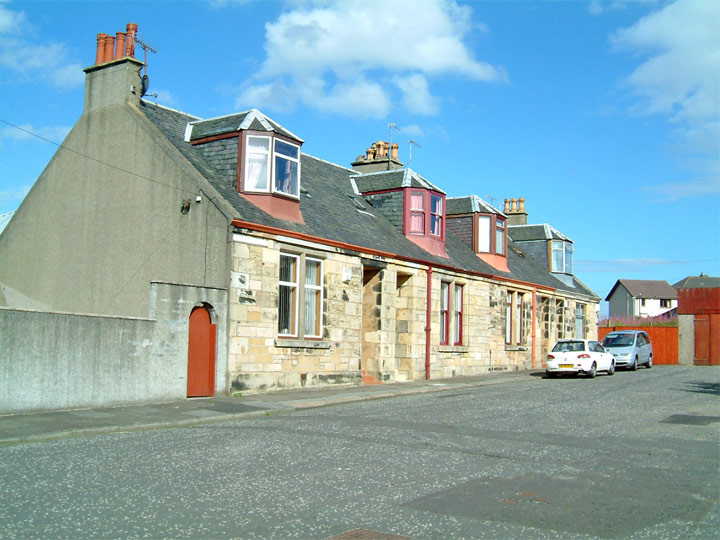
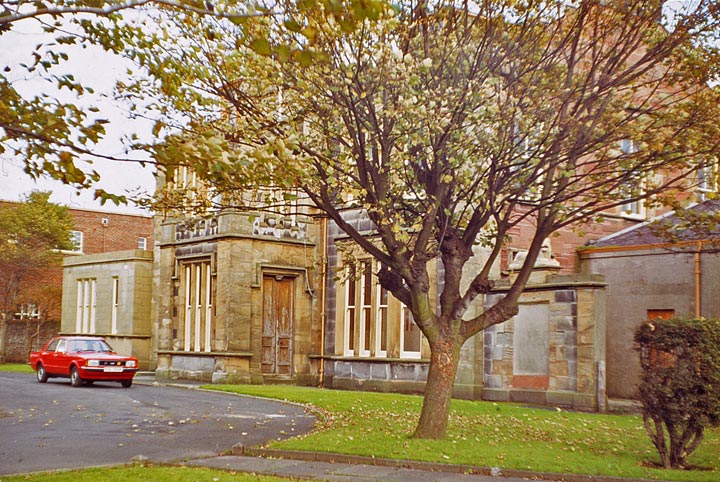

Ardrossan
and Saltcoats Herald, 30 October 1896
ARDROSSAN UNITED PRESBYTERIAN
CHURCH RAISES MONEY FOR ARMENIAN DISTRESS FUND
The Ardrossan United Presbyterian
Church on Sabbath last (25 October 1896) contributed £3 15s 11d to the
Armenian Distress Fund.
Ardrossan
and Saltcoats Herald, 30 October 1896
ARDROSSAN NEW PARISH CHURCH
RAISES MONEY FOR WESTERN INFIRMARY
The special collection in the New Parish Church, Ardrossan on Sabbath (25 October
1896) on behalf of the Western Infirmary amounted to £9.
Ardrossan
and Saltcoats Herald, 30 October 1896
NEW CHEMIST IN ARDROSSAN
Mr William Wallace has succeeded to the business of chemist and druggist so
long and successfully carried out in Ardrossan by Mr Andrew McInnes. Mr Wallace
has had considerable experience in his profession both in Edinburgh and in England.
Ardrossan
and Saltcoats Herald, 30 October 1896
NEW ARDROSSAN MINSTREL TROUPES
There are two amateur minstrel troupes in Ardrossan. The first in the field
was that known by the distinctive title of Snowball and we understand the public
will have the opportunity of judging of there capabilities as entertainers on
an early occasion. Meanwhile, they are practicing hard so that they will may
have no occasion to blush under their temporary swarthy complexions.
Ardrossan
and Saltcoats Herald, 30 October 1896
HALLOWE'EN CELEBRATIONS IN
SALTCOATS AND ARDROSSAN
A big lot of Saltcoats boys beautifully observed Hallowe'en on Friday night
(31 October 1896). Young Ardrossan trooped in from the country with an imposing
load of turnips. The demand for fruit was unusually great.
Ardrossan
and Saltcoats Herald, 6 November 1896
PLENTY BARRELS FOR DUCKING
FOR APPLES
There need be no scarcity of apples in Ardrossan for ducking purposes. At the
fruit market in Glasgow Street, there are no fewer than that seventy-three barrels
to select from. For some time past, the energetic proprietors have been disposing
of fifty barrels per week.
Ardrossan
and Saltcoats Herald, 30 October 1896
QUADRILLE CLASS IN ARDROSSAN
The select quadrille class under Mr Haldane in Ardrossan is said to have had
a successful inauguration last Saturday (7 November 1896).
Ardrossan
and Saltcoats Herald, 13 November 1896
ARDROSSAN CALEDONIAN RAILWAY
AMBULANCE TEAM COMPETE FOR CALEDONIAN CUP
Emulation is a fruitful source of activity. The Ardrossan Caledonian Railway
Ambulance team have been studying doggedly and manfully for some time past and
they go to Glasgow tomorrow (7 November 1896) strong in the determination to
carry off the Caledonian Cup. May success be in their train and training!
Ardrossan
and Saltcoats Herald, 6 November 1896
ARDROSSAN CALEDONIAN RAILWAY
AMBULANCE TEAM COMPETE FOR CALEDONIAN CUP
In the contest for the Caledonian Cup last Saturday (7 November 1896) made a
most creditable appearance gaining fourth place. They just beat Hamilton. The
figures were theory - 95 per cent, practice - 74 per cent. For theory, they
were second. The cup went to Polmadie. The Buchanan Street team, who were the
cup holders, had to be content with second place. From Aberdeen to Carlisle
is a wide area to draw upon and the Ardrossan team may be forgiven if they have
carried themselves somewhat jauntily this week. Doctor Macdonald deserves hearty
congratulation.
Ardrossan
and Saltcoats Herald, 13 November 1896
CYCLE TRADER DIES IN ARDROSSAN
Mr William Jamieson, cycle agent, well-known in Beith and also in Ardrossan,
died at his residence, Princes Street, Ardrossan on Monday night (23 November
1896). Mr Jamieson was a native of Kilmarnock but was connected with Beith for
over forty years, carrying on business as a photographer for thirty-eight years.
He early turned his attention to the cycling trade and was among the first makers
of bicycles the country produced. He was twenty-five years in the cycle trade
in Beith and started business in Ardrossan three summers ago. He enjoyed considerable
distinction locally as a road racer.
Ardrossan
and Saltcoats Herald, 27 November 1896
HONESTY IN ARDROSSAN
Honesty is among the shining virtues of Ardrossan. Here is something like a
full and accurate list of articles found and delivered at the Police Station
(shown below in 2002) since May last - four £1 notes, two half sovereigns,
£1 11s, watch and chain value £1 10s, gold watch valued £7
10s, gold watch and chain value £16, gold ring, gold bracelet value £5
and a silver badge with gold centre, In the majority of cases, finds have been
made by people belonging to labouring classes - adults and children. The curious
thing is that the money is very seldom reclaimed. After the lapse of a certain
time fixed by the law, it becomes the property of the finder.
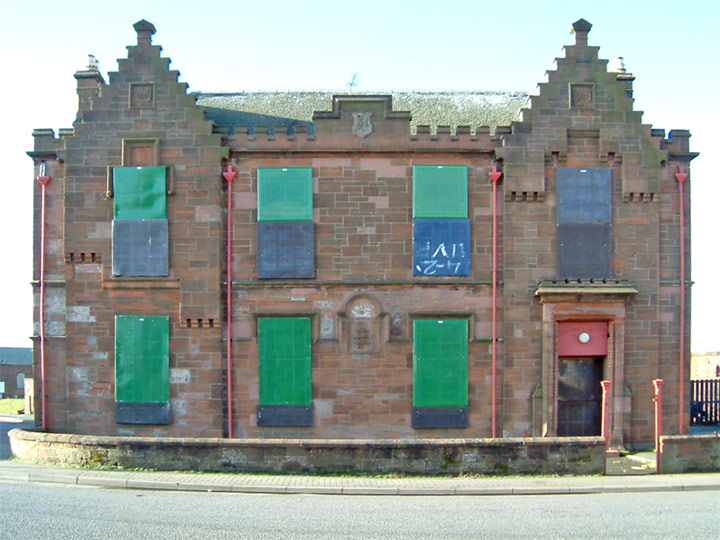
Ardrossan
and Saltcoats Herald, 4 December 1896
ARDROSSAN
SNOWFLAKE AMATEUR MINSTRELS
On Friday evening last (4 December 1896), the above combination made their first
appearance in the Assembly Hall, Ardrossan (shown below as the Winton Rovers'
Club in 1974). Eight o'clock was the advertised hour of starting but long before
that time, the hall was filled in every part and latecomers had to content themselves
with standing room while a good amount of money was refused at the door. The
large attendance was no doubt due to the Minstrels being, with one or two exceptions,
local gentlemen. The overture and opening chorus were given in good style though
taking into consideration the large chorus, the volume of sound was somewhat
weak. This may have been attributable to the occasion being their debut before
the public and is more than likely to be remedied in the future. The songs and
choruses in the first part of the programme, with one or two exceptions, were
well rendered. Someday I'll Wander Back Again by Mr Alexander, Meet Me At The
Golden Gate by Mr Sam Crowe and My Old Kentucky Home Goodnight with banjo accompaniment
by Mr J Seph prevailed musical talent of first-rate quality. Mr Hurst's make-up
for his song, I'm In Love With A Dandy-Coloured Coon, provoked considerable
laughter and song and chorus went well. Mr A Kay's singing of Say Au Revoir
was a splendid effort and he was deservedly encored. The patter, which was in
every case entirely free from vulgarity, was nearly always of the lively order
while the local allusions - the pavement question, of course - came in for a
due share of attention, were evidently relished by the audience. The second
part of the programme was of a varied character, the early numbers demanding
frequent encores. These embraced a Humorous Duet, a Stump Speech and a Humorous
Interlude by members of the Dennistoun Amateur Minstrels and the confidence
which the two gentlemen showed when before the footlights testified to what
may be looked for from the Snowflake Minstrels in due course. The Coon Trio
gave a deservedly appreciated banjo selection and Mr S Shields sang with expression
and good taste a Tyrolean song in character. The entertainment concluded with
a humorous travesty - The Theatrical Agency - the work of a member of the company
and this afforded a good deal of amusement in the audience. The parts were not
however well-balanced and the conclusion was decidedly tame and ineffective.
We would recommend the Minstrels to adopt a shorter piece and, unless it is
contrary to Minstrel laws, conclude their performance with a spirited plantation
memory. Mr Hannah and his band rendered good service as orchestra, Mr Stanley
Slater acting as accompanist most satisfactorily. The baton was wielded by Mr
Craig and it is probably owing to this fact that the time all-round was good.
Taken all together, the Snowflake Minstrels have no reason to be ashamed of
their first appearance. Keeping in view that they are purely an amateur combination,
they did exceedingly well and with a little attention to the strengthening of
the weak parts, they should be able to overcome the trifling difficulties which
presented themselves on Friday night. The committee regret the disappointment
to some thick-holders through their inability to get seats and request us to
say that the price of their tickets will be refunded on presenting same at the
shop of Messrs A Guthrie and Son.

Ardrossan
and Saltcoats Herald, 11 December 1896
PRESENTATION TO MAJOR HOGARTH,
ARDROSSAN
Major Hogarth, Ardrossan, will be presented with a long-service medal in the
Drill Hall on Wednesday evening (16 December 1896). Colonel Sturrock will make
the presentation. Friends will be welcome on the occasion.
Ardrossan
and Saltcoats Herald, 11 December 1896

















 On
Monday evening (11 May 1896), in the hall of Ardrossan New Parish Church, Mr
Hugh Littlejohn (shown right), well-known and esteemed as a townsman and valued
in the congregation in the new Parish Church as a neighbour and genial secretary
and treasurer was presented with a handsome gold watch and chain and also with
a beautiful silver teaset for Mrs Littlejohn. Mr Littlejohn leaves Ardrossan
for Troon. The presentation took place at a meeting held in the church hall
early in the evening at which ex-Bailie Macdonald, South Crescent, presided.
Notwithstanding the early hour - five o'clock - there was a good attendance,
the ladies of the congregation and also gentlemen who had been associated with
Mr Littlejohn in his work being present in goodly number.
On
Monday evening (11 May 1896), in the hall of Ardrossan New Parish Church, Mr
Hugh Littlejohn (shown right), well-known and esteemed as a townsman and valued
in the congregation in the new Parish Church as a neighbour and genial secretary
and treasurer was presented with a handsome gold watch and chain and also with
a beautiful silver teaset for Mrs Littlejohn. Mr Littlejohn leaves Ardrossan
for Troon. The presentation took place at a meeting held in the church hall
early in the evening at which ex-Bailie Macdonald, South Crescent, presided.
Notwithstanding the early hour - five o'clock - there was a good attendance,
the ladies of the congregation and also gentlemen who had been associated with
Mr Littlejohn in his work being present in goodly number.











 It
is interesting at this landmark in the history of the Burgh to recall the steps
taken by the first Council to organise its business and as showing the subjects
which engaged the attention of the 'Fathers' till 1858, when the foundation
stone was laid of the Townhouse, we give a few notes as gleaned from the Council's
minute book. The first minute in the Burgh records bears date 5 November 1846
when the newly-elected Councillors were sworn in by the Sheriff. On the day
following, there was a meeting when, as a matter of course, the appointment
of officials, committees, etc was the chief business transacted. Afterwards,
the Town Clerk was instructed to draw up a short memorial and queries in reference
to points connected with the Act and submit these to a Glasgow writer of some
standing for his opinion. John Gourlay, Gas Manager, was appointed Surveyor
of the Burgh and instructed to proceed forthwith 'to make up a rental of
the Burgh'. James Willock, Adam Barrie, Archibald Russell, Peter Barclay
and William Fullerton were appointed a Standing Committee. In addition to other
things, 'the Standing Committee were requested to survey the Burgh and ascertain
the state of the pavements, lanes and thoroughfares and to report the same to
next meeting'. Pavements then, as now, seem to have been a burning question.
Amongst the first acts the Commissioners performed was to take over the street
lighting and an offer from the Gas Company to light the street lamps, charging
at the rate of seven shillings per lamp was accepted. At a very early stage
also, the Burgh authorities insisted on kerb-stones being put down as 'boundaries
of pavements in lanes'. From minute of that meeting held on 7 December 1846,
it appears that the Clerk had issued notices to proprietors in terms of the
report of the Standing Committee. From subsequent minutes, it appears that one
proprietor refused compliance whereupon the Commissioners, after due exhortation
to which he appears to have paid no heed, had the work done at his expense.
The taxed accounts of the expenses connected with the procuring of the Burgh
Act appears in a minute of this period to have amounted to £1128 9s 5d.
To meet this, a loan was negotiated with the Bank of Scotland (whose Ardrossan
branch is shown right as the Community Education Office in 2003), Lord Eglinton
giving his personal obligation to the bond in addition to that of the Magistrates
and Council. At a meeting on 4 January 1847, 'the Clerk produced subscription
lists for building at courthouse and Town Hall and the meeting appointed the
Provost to wait upon Lord Eglinton with said list and to request his support
to the proposed scheme'. At the following meeting, the Clerk was instructed
to 'prepare lists of the proprietors with the rents of their properties,
showing the subscription payable by each, being one-fourth of a year's rent'
and at the meeting immediately following this one, the Clerk stated that the
gross amount of the rental was '£4214 14s and supposing each proprietor
were to subscribe a fourth of the year's rent, the sum of £1050 8s would
be raised in aid of the funds for building the proposed Town Hall and Courthouse'.
At a meeting held on 15 September 1847, 9d per £ was fixed as the rate
of assessment to be levied for the year from Whitsunday previous to Whitsunday
following. At the same meeting, Mr John Hogarth was appointed auditor of accounts.
At a meeting held on 11 May 1848, the Commissioners authorised the payment of
the first expenses incurred by them in the law courts which amounted to £11.
At a meeting held on 3 June of the same year, it was agreed to memorialise the
Belfast Chamber of Commerce in favour of a proposal to change the Mail Packet
stations from Portpatrick and Donaghadee to Belfast and Ardrossan.
It
is interesting at this landmark in the history of the Burgh to recall the steps
taken by the first Council to organise its business and as showing the subjects
which engaged the attention of the 'Fathers' till 1858, when the foundation
stone was laid of the Townhouse, we give a few notes as gleaned from the Council's
minute book. The first minute in the Burgh records bears date 5 November 1846
when the newly-elected Councillors were sworn in by the Sheriff. On the day
following, there was a meeting when, as a matter of course, the appointment
of officials, committees, etc was the chief business transacted. Afterwards,
the Town Clerk was instructed to draw up a short memorial and queries in reference
to points connected with the Act and submit these to a Glasgow writer of some
standing for his opinion. John Gourlay, Gas Manager, was appointed Surveyor
of the Burgh and instructed to proceed forthwith 'to make up a rental of
the Burgh'. James Willock, Adam Barrie, Archibald Russell, Peter Barclay
and William Fullerton were appointed a Standing Committee. In addition to other
things, 'the Standing Committee were requested to survey the Burgh and ascertain
the state of the pavements, lanes and thoroughfares and to report the same to
next meeting'. Pavements then, as now, seem to have been a burning question.
Amongst the first acts the Commissioners performed was to take over the street
lighting and an offer from the Gas Company to light the street lamps, charging
at the rate of seven shillings per lamp was accepted. At a very early stage
also, the Burgh authorities insisted on kerb-stones being put down as 'boundaries
of pavements in lanes'. From minute of that meeting held on 7 December 1846,
it appears that the Clerk had issued notices to proprietors in terms of the
report of the Standing Committee. From subsequent minutes, it appears that one
proprietor refused compliance whereupon the Commissioners, after due exhortation
to which he appears to have paid no heed, had the work done at his expense.
The taxed accounts of the expenses connected with the procuring of the Burgh
Act appears in a minute of this period to have amounted to £1128 9s 5d.
To meet this, a loan was negotiated with the Bank of Scotland (whose Ardrossan
branch is shown right as the Community Education Office in 2003), Lord Eglinton
giving his personal obligation to the bond in addition to that of the Magistrates
and Council. At a meeting on 4 January 1847, 'the Clerk produced subscription
lists for building at courthouse and Town Hall and the meeting appointed the
Provost to wait upon Lord Eglinton with said list and to request his support
to the proposed scheme'. At the following meeting, the Clerk was instructed
to 'prepare lists of the proprietors with the rents of their properties,
showing the subscription payable by each, being one-fourth of a year's rent'
and at the meeting immediately following this one, the Clerk stated that the
gross amount of the rental was '£4214 14s and supposing each proprietor
were to subscribe a fourth of the year's rent, the sum of £1050 8s would
be raised in aid of the funds for building the proposed Town Hall and Courthouse'.
At a meeting held on 15 September 1847, 9d per £ was fixed as the rate
of assessment to be levied for the year from Whitsunday previous to Whitsunday
following. At the same meeting, Mr John Hogarth was appointed auditor of accounts.
At a meeting held on 11 May 1848, the Commissioners authorised the payment of
the first expenses incurred by them in the law courts which amounted to £11.
At a meeting held on 3 June of the same year, it was agreed to memorialise the
Belfast Chamber of Commerce in favour of a proposal to change the Mail Packet
stations from Portpatrick and Donaghadee to Belfast and Ardrossan.  At
a meeting on 2 October 1848, the Clerk produced and read to the meeting a copy
of minutes of meeting of sub-commitee and subscribers to Ardrossan New Parish
Church (shown left as Barony Saint John's Church in 2009) from which it appeared
that, according to an agreement come to at a meeting in Saltcoats, a statement
was prepared 'showing the least amount of territory which would be required
for the new parish that would afford the stipend for the minister (128 6s 8d)
inclusive of the sum allowed for communion elements'. Mr Fullerton suggested
that, in order to do away with all opposition from the heritors and to save
delay and expenses, 'the proposed parish should be a Burghal parish which
proposal the Town Council could effect by granting a bond to the Court of Session
for the stipend and that Lord Eglinton could grant the necessary bond in favour
of the Town Council to relieve them of the stipend in all time coming'.
The report also bore that Lord Eglinton had agreed to grant the Bond of Relief
to the Town Council in the matter above-mentioned. The meeting did not come
to any decision on the report. The entry regarding the New Parish Church is
under date 27 November when Provost Barr moved that a meeting of electors be
called to consider if the Council should grant a bond for the minister's stipend.
The motion was agreed to. In the minutes of the meeting held on 14 June 1849,
appears the following entry. 'The Clerk read to the meeting a letter from
Mr Johnstone, Lord Eglinton's factor to Provost Barr in reference to the plot
of ground acquired by the Magistrates and Council from Mr A Russell.'. The
plot of ground referred to was that on which the Town Hall and offices are now
built. The letter recalled the Commissioners to the fact that nothing had been
done in the matter and requested the Commissioners to inform Lord Eglinton whether
they still adhered to their original intention or had abandoned it altogether.
As a result of this letter, it was agreed to instruct the Clerk to write to
Mr Johnstone requesting him to fix a day of meeting the purpose of getting the
plot of ground laid off. 'The meeting agreed that the plot of ground should
be forty-five feet.'. With reference to the Cannon Hill (shown below right
in 2006), the following entry appears in the minutes of the meeting held on
16 August 1849. 'Provost Barr stated that he had called the present meeting
in consequence of a conversation he had had with Lord Eglinton at which meeting
his lordship had stated his regret that the strangers in Ardrossan this summer
had been so few and expressed his willingness to make public walks about the
Cannon Hill and other places in the neighbourhood at his lordship's expense
provided the Commissioners agree to pay a rent to him for the Cannon Hill. The
meeting having taken the Provost's statement into consideration authorised him
to arrange with Lord Eglinton in reference to the matter in the best way he
could and to report to a future meeting.'. The history of the negotiations
preceding the handing over the Cannon Hill to the town are doubtless within
the knowledge of many of our local readers. Hugh Chalmers, tenant of Parkhouse,
offered to give up the hill on condition that he should retain a right of road
through it to his adjoining field and that he should receive the same rent as
he paid to Lord Eglinton with the addition of £3 per annum during the
remainder of his lease but he afterwards claimed that, in addition to the rent
of the curling pond and the right-of-way across the lower part of the park,
the sum to be paid to him should be settled by arbitration. The record runs
that 'The meeting authorised the Provost to meet with Mr Chalmers and arrange
with him.'.
At
a meeting on 2 October 1848, the Clerk produced and read to the meeting a copy
of minutes of meeting of sub-commitee and subscribers to Ardrossan New Parish
Church (shown left as Barony Saint John's Church in 2009) from which it appeared
that, according to an agreement come to at a meeting in Saltcoats, a statement
was prepared 'showing the least amount of territory which would be required
for the new parish that would afford the stipend for the minister (128 6s 8d)
inclusive of the sum allowed for communion elements'. Mr Fullerton suggested
that, in order to do away with all opposition from the heritors and to save
delay and expenses, 'the proposed parish should be a Burghal parish which
proposal the Town Council could effect by granting a bond to the Court of Session
for the stipend and that Lord Eglinton could grant the necessary bond in favour
of the Town Council to relieve them of the stipend in all time coming'.
The report also bore that Lord Eglinton had agreed to grant the Bond of Relief
to the Town Council in the matter above-mentioned. The meeting did not come
to any decision on the report. The entry regarding the New Parish Church is
under date 27 November when Provost Barr moved that a meeting of electors be
called to consider if the Council should grant a bond for the minister's stipend.
The motion was agreed to. In the minutes of the meeting held on 14 June 1849,
appears the following entry. 'The Clerk read to the meeting a letter from
Mr Johnstone, Lord Eglinton's factor to Provost Barr in reference to the plot
of ground acquired by the Magistrates and Council from Mr A Russell.'. The
plot of ground referred to was that on which the Town Hall and offices are now
built. The letter recalled the Commissioners to the fact that nothing had been
done in the matter and requested the Commissioners to inform Lord Eglinton whether
they still adhered to their original intention or had abandoned it altogether.
As a result of this letter, it was agreed to instruct the Clerk to write to
Mr Johnstone requesting him to fix a day of meeting the purpose of getting the
plot of ground laid off. 'The meeting agreed that the plot of ground should
be forty-five feet.'. With reference to the Cannon Hill (shown below right
in 2006), the following entry appears in the minutes of the meeting held on
16 August 1849. 'Provost Barr stated that he had called the present meeting
in consequence of a conversation he had had with Lord Eglinton at which meeting
his lordship had stated his regret that the strangers in Ardrossan this summer
had been so few and expressed his willingness to make public walks about the
Cannon Hill and other places in the neighbourhood at his lordship's expense
provided the Commissioners agree to pay a rent to him for the Cannon Hill. The
meeting having taken the Provost's statement into consideration authorised him
to arrange with Lord Eglinton in reference to the matter in the best way he
could and to report to a future meeting.'. The history of the negotiations
preceding the handing over the Cannon Hill to the town are doubtless within
the knowledge of many of our local readers. Hugh Chalmers, tenant of Parkhouse,
offered to give up the hill on condition that he should retain a right of road
through it to his adjoining field and that he should receive the same rent as
he paid to Lord Eglinton with the addition of £3 per annum during the
remainder of his lease but he afterwards claimed that, in addition to the rent
of the curling pond and the right-of-way across the lower part of the park,
the sum to be paid to him should be settled by arbitration. The record runs
that 'The meeting authorised the Provost to meet with Mr Chalmers and arrange
with him.'.  There
the matter appeared to have rested for some time. The principle of at least
partial prohibition in regard to licences seems to have been accepted by the
Commissioners. Under date 17 April 1850 occurs the following entry 'The Provost
proposed that he and certain other parties should visit the public houses within
the Burgh with a view, if possible, to diminish their number and restrict the
hours during which they should be kept open to which the meeting agreed.'.
What was done in the matter does not appear but in a subsequent minute it is
recorded the Provost brought under the notice of the Commissioners 'the propriety
of warning the innkeepers and other retailers of spirits and other liquors within
the Burgh' against supplying liquor to lunatics, one of whom is specially
mentioned by name, or persons under age. When the late Joseph McCulloch was
the only officer, it was the custom to call him in and request him to report
on the how the public houses were conducted. One of the functions of the Commissioners
which now belongs to the Magistrates appears in the following entry - the first
of the kind - under date 14 May 1850. 'It was stated to the meeting that
it had been called in consequence of a breach of the peace which had been committed
in the Burgh last night. After some discussion, the meeting agreed to watch
the proceedings of parties who may commit a breach of the peace tonight and
thereafter to take steps to get the special constables organised.' Concerning
what further happened, no record is left to posterity. About the same time,
complaint began to be made about the number of beggars in the Burgh. No notice
was taken of the matter until 8 January 1851 under which date the following
entry appears. 'The Clerk was instructed to answer said letter and to state
that under existing circumstances it was impossible to remedy the evil complained
of until lock-up houses be erected.' and in the meantime the Commissioners
hoped the writer of the letter would not press the matter. Rigorous orders against
trespassers on the 'public' walks on the Castle Hill were issued and a hint
was conveyed to the watchman in the following terms 'The Clerk was instructed
to inform the watchman that unless he reported trespassers, his services would
be dispensed with'. Further, 'The Committee of Commissioners were instructed
to shift the door into the Castle Hill from the Cannon Hill or to put up a fence
to said door and the Clerk was instructed to give notice by handbill that no-one
was to be allowed to dry or spread clothes on the Castle Hill or walks and that
all parties found trespassing on said walks would be prosecuted, the same notice
as to trespassing to be sent through Saltcoats.'. At a meeting held on 27
September 1858, offers for the erection of the proposed Town House were opened
and examined and the Clerk was instructed to send same to Mr Gairdner, Lord
Eglinton's factor, for his remarks previous to fixing upon the contractors.
The plans seem to have been considered satisfactory and on 30 October, the foundation
stone was laid with Masonic honours by George Johnstone esquire of Redburn,
Mr D C Love, G A, Ardrossan placing the coins of the realm and the usual documents
in the cavity which was afterwards covered with a brass plate bearing the following
inscription 'This stone laid on 30 October 1858 by the Mother Lodge of Free
Masons, Kilwinning. George Johnstone P G M, Hugh Conn D G M, Robert Boyd S G
M, Charles Breckenridge S P W, James Hendrie Past P W'. We need not quote
further from the minutes. In the minutes of 19 December 1850, appears the following
entry from which date the proceeding have been reported 'The Clerk read the
following letter from Mr Arthur Guthrie, publisher of the Ardrossan and Saltcoats
Herald. Representation having been made to me, as publisher as publisher of
the local paper that reports of the meetings of Town council would be acceptable.
I take the liberty of requesting permission for my reporter being present for
that purpose.'. The Clerk was instructed to intimate to Mr Guthrie that
the Commissioners had no objection to his attending the four statutory quarterly
meetings appointed to be held annually under the Act. This permission was later
extended to all monthly meetings. Until the death of Provost Barr in 1884, the
only important developments of the Burgh which we can recall after 1858 are
the formation of the artillery corps in 1859, the organisation of the United
Presbyterian Church in 1857, the Episcopal Church in 1873 and the acquisition
of the old Bute Place by the Glasgow and South West Railway Company for the
erection of their new offices in 1874. Like the New Parish Church, the Independent
Church and the Free Church were organised before the Burgh Act was passed, the
former in 1837 and the latter in 1844. For some years, there was something of
a stand-still and it was not until there was a talk of an extension of the harbour
and the introduction of a new railway that the breadth of a new life began to
be felt.
There
the matter appeared to have rested for some time. The principle of at least
partial prohibition in regard to licences seems to have been accepted by the
Commissioners. Under date 17 April 1850 occurs the following entry 'The Provost
proposed that he and certain other parties should visit the public houses within
the Burgh with a view, if possible, to diminish their number and restrict the
hours during which they should be kept open to which the meeting agreed.'.
What was done in the matter does not appear but in a subsequent minute it is
recorded the Provost brought under the notice of the Commissioners 'the propriety
of warning the innkeepers and other retailers of spirits and other liquors within
the Burgh' against supplying liquor to lunatics, one of whom is specially
mentioned by name, or persons under age. When the late Joseph McCulloch was
the only officer, it was the custom to call him in and request him to report
on the how the public houses were conducted. One of the functions of the Commissioners
which now belongs to the Magistrates appears in the following entry - the first
of the kind - under date 14 May 1850. 'It was stated to the meeting that
it had been called in consequence of a breach of the peace which had been committed
in the Burgh last night. After some discussion, the meeting agreed to watch
the proceedings of parties who may commit a breach of the peace tonight and
thereafter to take steps to get the special constables organised.' Concerning
what further happened, no record is left to posterity. About the same time,
complaint began to be made about the number of beggars in the Burgh. No notice
was taken of the matter until 8 January 1851 under which date the following
entry appears. 'The Clerk was instructed to answer said letter and to state
that under existing circumstances it was impossible to remedy the evil complained
of until lock-up houses be erected.' and in the meantime the Commissioners
hoped the writer of the letter would not press the matter. Rigorous orders against
trespassers on the 'public' walks on the Castle Hill were issued and a hint
was conveyed to the watchman in the following terms 'The Clerk was instructed
to inform the watchman that unless he reported trespassers, his services would
be dispensed with'. Further, 'The Committee of Commissioners were instructed
to shift the door into the Castle Hill from the Cannon Hill or to put up a fence
to said door and the Clerk was instructed to give notice by handbill that no-one
was to be allowed to dry or spread clothes on the Castle Hill or walks and that
all parties found trespassing on said walks would be prosecuted, the same notice
as to trespassing to be sent through Saltcoats.'. At a meeting held on 27
September 1858, offers for the erection of the proposed Town House were opened
and examined and the Clerk was instructed to send same to Mr Gairdner, Lord
Eglinton's factor, for his remarks previous to fixing upon the contractors.
The plans seem to have been considered satisfactory and on 30 October, the foundation
stone was laid with Masonic honours by George Johnstone esquire of Redburn,
Mr D C Love, G A, Ardrossan placing the coins of the realm and the usual documents
in the cavity which was afterwards covered with a brass plate bearing the following
inscription 'This stone laid on 30 October 1858 by the Mother Lodge of Free
Masons, Kilwinning. George Johnstone P G M, Hugh Conn D G M, Robert Boyd S G
M, Charles Breckenridge S P W, James Hendrie Past P W'. We need not quote
further from the minutes. In the minutes of 19 December 1850, appears the following
entry from which date the proceeding have been reported 'The Clerk read the
following letter from Mr Arthur Guthrie, publisher of the Ardrossan and Saltcoats
Herald. Representation having been made to me, as publisher as publisher of
the local paper that reports of the meetings of Town council would be acceptable.
I take the liberty of requesting permission for my reporter being present for
that purpose.'. The Clerk was instructed to intimate to Mr Guthrie that
the Commissioners had no objection to his attending the four statutory quarterly
meetings appointed to be held annually under the Act. This permission was later
extended to all monthly meetings. Until the death of Provost Barr in 1884, the
only important developments of the Burgh which we can recall after 1858 are
the formation of the artillery corps in 1859, the organisation of the United
Presbyterian Church in 1857, the Episcopal Church in 1873 and the acquisition
of the old Bute Place by the Glasgow and South West Railway Company for the
erection of their new offices in 1874. Like the New Parish Church, the Independent
Church and the Free Church were organised before the Burgh Act was passed, the
former in 1837 and the latter in 1844. For some years, there was something of
a stand-still and it was not until there was a talk of an extension of the harbour
and the introduction of a new railway that the breadth of a new life began to
be felt. The
choice of John Barr (shown right in 1878) as Provost was a happy one, Born in
Lochwinnoch in 1798, he was a self-made man and one other illustration of the
kind of men who at the beginning of this century were reared under a weaver's
roof and inherited from worthy parents that grit and strength of character which
has made healthy Scotchmen famous all over the world. Leaving the loom on which
he worked as a boy, he became a contractor and it was the railway hence to Kilwinning
which brought him to Ardrossan in the year 1828. He afterwards contracted the
deepening of the old harbour and the building of the sea-wall in front of Montgomerie
Street, the space intervening once a green esplanade now covered with lines
of rails, being filled in by the soil taken out of the harbour. In 1842, in
company with the late James Shearer, he entered on the business of shipbuilding.
In association with Mr Shearer, he thus became a large employer of labour for
shipbuilding flourished and with the development of that and other branches
of industry such as the Engineering Works if Provost Young, the Foundry of the
Messrs Goodwin and the 'wee yaird' of Mr Peter Barclay, the population of the
town rapidly increased. To such an extent did Provost Barr meet the demands
for shop and house accommodation that possibly at one time one-fifth of the
town, if not more, belonged to him. He was a Justice of the Peace, chairman
for many years of the Gas and Water Company of which he was an active promoter,
first Chairman of the School Board and a trustee of the New Parish Church. To
be Provost of the Burgh for thirty-eight years was in itself a striking testimony
of the high estimate placed upon his value as a citizen. His life and the life
of the town has been closely interwoven during these years. In a very true sense,
he was one of its 'Makers' and pleasing evidence of the general recognition
of this fact was furnished when in 1878, he was presented with his portrait,
painted by Norman Macbeth, ARS, and which now hangs in the Town Hall, the presentation
being made by Sir James Fergusson at a meeting presided over by the Earl of
Eglinton.
The
choice of John Barr (shown right in 1878) as Provost was a happy one, Born in
Lochwinnoch in 1798, he was a self-made man and one other illustration of the
kind of men who at the beginning of this century were reared under a weaver's
roof and inherited from worthy parents that grit and strength of character which
has made healthy Scotchmen famous all over the world. Leaving the loom on which
he worked as a boy, he became a contractor and it was the railway hence to Kilwinning
which brought him to Ardrossan in the year 1828. He afterwards contracted the
deepening of the old harbour and the building of the sea-wall in front of Montgomerie
Street, the space intervening once a green esplanade now covered with lines
of rails, being filled in by the soil taken out of the harbour. In 1842, in
company with the late James Shearer, he entered on the business of shipbuilding.
In association with Mr Shearer, he thus became a large employer of labour for
shipbuilding flourished and with the development of that and other branches
of industry such as the Engineering Works if Provost Young, the Foundry of the
Messrs Goodwin and the 'wee yaird' of Mr Peter Barclay, the population of the
town rapidly increased. To such an extent did Provost Barr meet the demands
for shop and house accommodation that possibly at one time one-fifth of the
town, if not more, belonged to him. He was a Justice of the Peace, chairman
for many years of the Gas and Water Company of which he was an active promoter,
first Chairman of the School Board and a trustee of the New Parish Church. To
be Provost of the Burgh for thirty-eight years was in itself a striking testimony
of the high estimate placed upon his value as a citizen. His life and the life
of the town has been closely interwoven during these years. In a very true sense,
he was one of its 'Makers' and pleasing evidence of the general recognition
of this fact was furnished when in 1878, he was presented with his portrait,
painted by Norman Macbeth, ARS, and which now hangs in the Town Hall, the presentation
being made by Sir James Fergusson at a meeting presided over by the Earl of
Eglinton. John
Hogarth, (shown left around the 1870s), who had been elected to the Town Council
in 1851, had been treasurer from 1852 to 1858 and Bailie from 1859, succeeded
to the Provostship on the death of Provost Barr in 1884. A native of Stevenston,
in early life he was apprenticed to Messrs Fullerton, ironmongers, Saltcoats
and in 1842, represented them in Ardrossan. After being a short time in Glasgow,
he returned to Ardrossan as partner with the late William Fullerton who retired
in 1851, the year Mr Hogarth entered the Town Council. His election to the office
of Chief magistrate was at a time when his intimate knowledge of every department
of the town's affairs was invaluable. In 1884, the Lanarkshire and Ayrshire
Railway Act was passed and four years later was opened for traffic. At the same
time, a Bill was passed for the extension of the harbour under a company which
was completed and opened in 1892. The gas and water supply which had been in
the hands of an amalgamated company from 1874 and of which the Provost had been
a director and latterly chairman, was in 1886 purchased by the town. In 1882,
he was added to the Commissioners of the Peace. In 1883, he represented the
Burgh on the Irvine District Roads Board. In 1885, he was enrolled a Commissioner
of Supply and in 1888 was elected a member of the County Roads Board. The experience
thus acquired was of great service when, as representative of Ardrossan on the
County Council, he succeeded in getting the roads, which had been taken over
by that authority in 1891, placed under the management of the Town Council.
It is no small matter to give forty-years service to the public and ex-Provost
Hogarth's term of office is not only memorable because embracing some of the
most progressive events in the history of the Burgh, but for the practical sagacity
and the wide experience and ability which he brought to bear on the business.
He was in office when the breath of new life referred to was beginning to be
felt and he worthily represented the Burgh before Parliamentary Committee and
at the inauguration of the extension of the harbour and the opening of the new
railway.
John
Hogarth, (shown left around the 1870s), who had been elected to the Town Council
in 1851, had been treasurer from 1852 to 1858 and Bailie from 1859, succeeded
to the Provostship on the death of Provost Barr in 1884. A native of Stevenston,
in early life he was apprenticed to Messrs Fullerton, ironmongers, Saltcoats
and in 1842, represented them in Ardrossan. After being a short time in Glasgow,
he returned to Ardrossan as partner with the late William Fullerton who retired
in 1851, the year Mr Hogarth entered the Town Council. His election to the office
of Chief magistrate was at a time when his intimate knowledge of every department
of the town's affairs was invaluable. In 1884, the Lanarkshire and Ayrshire
Railway Act was passed and four years later was opened for traffic. At the same
time, a Bill was passed for the extension of the harbour under a company which
was completed and opened in 1892. The gas and water supply which had been in
the hands of an amalgamated company from 1874 and of which the Provost had been
a director and latterly chairman, was in 1886 purchased by the town. In 1882,
he was added to the Commissioners of the Peace. In 1883, he represented the
Burgh on the Irvine District Roads Board. In 1885, he was enrolled a Commissioner
of Supply and in 1888 was elected a member of the County Roads Board. The experience
thus acquired was of great service when, as representative of Ardrossan on the
County Council, he succeeded in getting the roads, which had been taken over
by that authority in 1891, placed under the management of the Town Council.
It is no small matter to give forty-years service to the public and ex-Provost
Hogarth's term of office is not only memorable because embracing some of the
most progressive events in the history of the Burgh, but for the practical sagacity
and the wide experience and ability which he brought to bear on the business.
He was in office when the breath of new life referred to was beginning to be
felt and he worthily represented the Burgh before Parliamentary Committee and
at the inauguration of the extension of the harbour and the opening of the new
railway. On
the retiral of Provost Hogarth in 1893, the choice of the Commissioners fell
upon Mr William Young (shown left around the 1880s). A native of Cupar, Fifeshire,
he came to Ardrossan as far back as 1856 to take charge of the engineering department
of the harbour under the late Mr John Moffat and form 1865 has managed a large
engineering business on his own account. He was first elected to the Council
Board under the old Act but was only a few months in office. He entered the
Council again in 1887 when his practical ability could be turned to good account.
The Gas and Water had been acquired by the town and great improvements were
begun of contemplated. Within Provost Young's term of service as Councillor
and Provost, the new reservoir was made, two new filters introduced, the drainage
of the town improved by the old built drains being replaced by pipe drains,
the bucket system of daily cleansing adopted which has done much for the sanitary
welfare of the town and at his recommendation, a reconstruction of the Gas Works
by adapting it for the oil enrichment process with the result that the cost
of gas to the consumers has been reduced from 4s 2d to 3s 4d for 1000 feet.
At the present time, new crossings are being laid and the pavement question,
however it may be settled, is certain to result in a greatly improved town.
Provost Young is a Justice of the Peace and represents Ardrossan on the Technical
Education Committee of the County Council. It was also due to his initiative
that the grant-in-aid for these two years past has been devoted by the Commission
to the promotion of Technical Education classes.
On
the retiral of Provost Hogarth in 1893, the choice of the Commissioners fell
upon Mr William Young (shown left around the 1880s). A native of Cupar, Fifeshire,
he came to Ardrossan as far back as 1856 to take charge of the engineering department
of the harbour under the late Mr John Moffat and form 1865 has managed a large
engineering business on his own account. He was first elected to the Council
Board under the old Act but was only a few months in office. He entered the
Council again in 1887 when his practical ability could be turned to good account.
The Gas and Water had been acquired by the town and great improvements were
begun of contemplated. Within Provost Young's term of service as Councillor
and Provost, the new reservoir was made, two new filters introduced, the drainage
of the town improved by the old built drains being replaced by pipe drains,
the bucket system of daily cleansing adopted which has done much for the sanitary
welfare of the town and at his recommendation, a reconstruction of the Gas Works
by adapting it for the oil enrichment process with the result that the cost
of gas to the consumers has been reduced from 4s 2d to 3s 4d for 1000 feet.
At the present time, new crossings are being laid and the pavement question,
however it may be settled, is certain to result in a greatly improved town.
Provost Young is a Justice of the Peace and represents Ardrossan on the Technical
Education Committee of the County Council. It was also due to his initiative
that the grant-in-aid for these two years past has been devoted by the Commission
to the promotion of Technical Education classes. It
was on a lovely afternoon of July 1896 that I set sail from Ardrossan in the
good ship Peeweep for New York. My father was the captain of the vessel and
very proud was I, at the age of ten, to take this my first voyage with him.
In fact, we voyaged en famille for it had been determined to set up house on
the other side of the Atlantic. My career in the new country, I need not recount.
Enough that, having secured a comfortable competency for life, I now find myself
once again in Ardrossan in this year of grace, 1946. Fifty years have come and
gone since the Peeweep dropped down by Arran that summer day in the end of the
nineteenth century and I cannot tell you how often in the interval I was beset
with a deep longing to revisit the little town on the Ayrshire coast where the
dry winds were always piping and the railway engines always shunting. Gradually,
my resolve grew more definitive, that in my declining years I would settle down
in Ardrossan and here is my ambition realised. They tell me it is now exactly
a century since Ardrossan was constituted a Burgh with a town council , a provost
and bailies. Foraging, by the editor's kind permission, in the files of the
Ardrossan and Saltcoats Herald, I came the other day on a sketch of the town's
progress, published on the occasion of the municipal jubilee. Now that the centenary
has come round, I fall involuntarily into a comparison of what the place is
now in contrast to what it was in my boyhood's days. Glasgow Street, of which
I have a dreary memory as of a long unlovely street, is today of the same length
and breadth and is made up, for the most part, of the same houses as formerly
but a number of improvements have been carried out with the result that the
street is now a handsome and beautiful thoroughfare. The surface which used
to be macadamised like a turnpike road, is now causewayed with smooth close-fitting
stones. The pavements are of uniform breadth and material and in the best of
repair. A line of trees on either side has, in spite of the gale that still
may sweep the street, grown into tolerable height and foliage and suggests a
delightful boulevard air. At night, when it is lit, like the entire town, with
the electric light, it presents the appearance of an illuminated vista. The
gas works, for gas is not likely to be superseded, no longer stands in Glasgow
Street, having been removed to the outskirts. The long high red wall that used
to stand with prison-like aspect below the United Presbyterian Church (shown
right as the Church of the Nazarene in 2002) has disappeared and you look instead
clean away up to the Cannon Hill. The trees which were planted around the United
Presbyterian Church just before I left the town have grown up into surprising
luxuriance. Several new handsome building now enhance the street. Certain old
houses, near what used to be the Infant's School, have been taken down and on
their site stands the Free Public Library and Reading Room which a number of
generous citizens united in bestowing on the community. At the top of the street,
opposite the school, a fountain of wrought-iron plays while at the Princes Street
end, there is a statue to the good Queen Victoria of blessed memory. The public
houses have disappeared but in some four or five street, there is a large airy
restaurant managed on a modification of the Scandinavian system. In some of
these places of refreshment no alcoholic beverages can be obtained while in
others there is no restriction but in these latter, the liquor sold is certified
free form adulteration, The officials are well-paid, responsible men whose interest
it is to encourage temperance and I must confess that one does not nowadays
see a drunken man with a fraction of the frequency of my young days. In Princes
Street, there are new municipal buildings of imposing architecture with a spacious
hall for public meetings and entertainments and they tell me much more interest
is now taken in municipal elections, the Commissioners' Board being composed
of the ablest and most reputable citizens. Opposite the Police Station stand
the Public Baths with salt and fresh water where the poorest may perform weekly
or daily ablutions and attached to the Baths are a gymnasium and recreation
hall. The lanes of the town are things of the past. Quarry Lane (shown below
upper right as disused ground around the 1930s) has disappeared and others have
been renovated beyond recognition.
It
was on a lovely afternoon of July 1896 that I set sail from Ardrossan in the
good ship Peeweep for New York. My father was the captain of the vessel and
very proud was I, at the age of ten, to take this my first voyage with him.
In fact, we voyaged en famille for it had been determined to set up house on
the other side of the Atlantic. My career in the new country, I need not recount.
Enough that, having secured a comfortable competency for life, I now find myself
once again in Ardrossan in this year of grace, 1946. Fifty years have come and
gone since the Peeweep dropped down by Arran that summer day in the end of the
nineteenth century and I cannot tell you how often in the interval I was beset
with a deep longing to revisit the little town on the Ayrshire coast where the
dry winds were always piping and the railway engines always shunting. Gradually,
my resolve grew more definitive, that in my declining years I would settle down
in Ardrossan and here is my ambition realised. They tell me it is now exactly
a century since Ardrossan was constituted a Burgh with a town council , a provost
and bailies. Foraging, by the editor's kind permission, in the files of the
Ardrossan and Saltcoats Herald, I came the other day on a sketch of the town's
progress, published on the occasion of the municipal jubilee. Now that the centenary
has come round, I fall involuntarily into a comparison of what the place is
now in contrast to what it was in my boyhood's days. Glasgow Street, of which
I have a dreary memory as of a long unlovely street, is today of the same length
and breadth and is made up, for the most part, of the same houses as formerly
but a number of improvements have been carried out with the result that the
street is now a handsome and beautiful thoroughfare. The surface which used
to be macadamised like a turnpike road, is now causewayed with smooth close-fitting
stones. The pavements are of uniform breadth and material and in the best of
repair. A line of trees on either side has, in spite of the gale that still
may sweep the street, grown into tolerable height and foliage and suggests a
delightful boulevard air. At night, when it is lit, like the entire town, with
the electric light, it presents the appearance of an illuminated vista. The
gas works, for gas is not likely to be superseded, no longer stands in Glasgow
Street, having been removed to the outskirts. The long high red wall that used
to stand with prison-like aspect below the United Presbyterian Church (shown
right as the Church of the Nazarene in 2002) has disappeared and you look instead
clean away up to the Cannon Hill. The trees which were planted around the United
Presbyterian Church just before I left the town have grown up into surprising
luxuriance. Several new handsome building now enhance the street. Certain old
houses, near what used to be the Infant's School, have been taken down and on
their site stands the Free Public Library and Reading Room which a number of
generous citizens united in bestowing on the community. At the top of the street,
opposite the school, a fountain of wrought-iron plays while at the Princes Street
end, there is a statue to the good Queen Victoria of blessed memory. The public
houses have disappeared but in some four or five street, there is a large airy
restaurant managed on a modification of the Scandinavian system. In some of
these places of refreshment no alcoholic beverages can be obtained while in
others there is no restriction but in these latter, the liquor sold is certified
free form adulteration, The officials are well-paid, responsible men whose interest
it is to encourage temperance and I must confess that one does not nowadays
see a drunken man with a fraction of the frequency of my young days. In Princes
Street, there are new municipal buildings of imposing architecture with a spacious
hall for public meetings and entertainments and they tell me much more interest
is now taken in municipal elections, the Commissioners' Board being composed
of the ablest and most reputable citizens. Opposite the Police Station stand
the Public Baths with salt and fresh water where the poorest may perform weekly
or daily ablutions and attached to the Baths are a gymnasium and recreation
hall. The lanes of the town are things of the past. Quarry Lane (shown below
upper right as disused ground around the 1930s) has disappeared and others have
been renovated beyond recognition.  The
classes that used to crowd the lanes now live in streets like Winton Street
(shown right in 2002) which now extends to South Beach Station (shown below
upper centre in 1986) or Seton Street and Park Road (shown below upper right
in 2002) which have greatly extended while numbers who, in my early days, would
have resided in these streets now occupy tidy cottages toward the north end
of the town. Eglinton Street exhibits an unbroken row of cottages as far as
Seafield while behind that row, another runs parallel. In each row, there is
a pleasing variety of style of buildings - some of red, some of yellow, some
of whiter sandstone. What used to be the high road to Saltcoats from the head
of Glasgow Street round by the Hospital is now a continuation of cottages and
villas, the Hospital having been removed further inland and being much more
in use for all kinds of infectious cases than formerly. I was surprised to find
that the Cemetery had not extended since my departure but I learned the explanation
when, close beside it and edifice of sober, pleasing architecture was pointed
out to me as the crematorium. Some fields in the neighbourhood of the Cemetery
have been rented as a golf course, the presence of which has increased the attractiveness
of our town as a seaside resort. The same result is augmented by the fact of
the grassy Esplanade railed off from the Caledonian line at the North Crescent
and by the reclamation of ground at the South Beach where what used to be sandy
beach is now a green recreation ground defended from the encroachment of the
waves by a solid wall. On both these promenades stands a picturesque shelter
for the band, the town now possessing a Burgh orchestra which performs frequently
in the open air in summer and in the public hall in the winter. This band is
made up of mechanics and tradesmen who are encouraged to the acquirement of
musical ability by a subsidy disbursed from the town's exchequer. Montgomerie
Street has been improved by a well-chisled stone wall mounted with an iron railing
in good design with shrubs for a background, shutting off from the view of foot-passengers
the waggons that still shunt up and down. There is no smoke now, steam having
been replaced by electricity. On the notice board of the Free Church, as on
that of the United Presbyterian and Established Church, I observed the legend
'Church of Scotland' reminding me how, in my absence, the divisions of Presbyterianism
had been healed and the church reconstructed on a purely spiritual basis and
indeed I remember the excitement and enthusiasm throughout the old country when
it was published abroad that the Established Church had, by unanimous action
of its General Assembly, renounced its secular connection with the State and
the concomitant emoluments in the interest of a reunited Presbyterianism and
how the country, through its Parliament, insisted on the church retaining these
sources of revenue so long consecrated to religious use. Looking
out on the Firth from the Caledonian Bridge, one notices vast changes in the
outline of the harbour. The old breakwater has disappeared and instead a wall
of a similar kind stretches from the Horse Island to the rocks that run out
from Burnfoot, thus forming a kind of lagoon which has been dredged and rendered
deep enough to accommodate large vessels. The sudden increase of the prosperity
of the town dates from the period when this change was carried out, Ardrossan
being now one of the most thriving shipping places of the west. The large house
which at one time was the residence of Provost Barr and which I remember as
the Caledonian Hotel (shown below lower left as the disused Burgh Chambers in
1976) has been purchased by the School Board and converted into and infant school.
The grounds are once more nicely laid out and are an adornment to the street.
The spirit of memory is upon me as I wander up the Castle Hill, there to sit
down and overlook the town and all its changes. The seat which I choose is one
within view of three imposing bronze statues. One of the figures is warrior-like,
the outstretched sword pointing to the ruins of Ardrossan Castle (shown below
lower right in the early 1900s). Of the second, the face is rugged but noble
as he stands there with his Geneva gown. Of the third, the subject is meditative,
the hand shading the eyes that gaze away towards auld Ayr. The one is Wallace,
the second Knox and the third Burns. After fifty years, I do not find that my
country men have lost their patriotism, their religion or their sentiment.
The
classes that used to crowd the lanes now live in streets like Winton Street
(shown right in 2002) which now extends to South Beach Station (shown below
upper centre in 1986) or Seton Street and Park Road (shown below upper right
in 2002) which have greatly extended while numbers who, in my early days, would
have resided in these streets now occupy tidy cottages toward the north end
of the town. Eglinton Street exhibits an unbroken row of cottages as far as
Seafield while behind that row, another runs parallel. In each row, there is
a pleasing variety of style of buildings - some of red, some of yellow, some
of whiter sandstone. What used to be the high road to Saltcoats from the head
of Glasgow Street round by the Hospital is now a continuation of cottages and
villas, the Hospital having been removed further inland and being much more
in use for all kinds of infectious cases than formerly. I was surprised to find
that the Cemetery had not extended since my departure but I learned the explanation
when, close beside it and edifice of sober, pleasing architecture was pointed
out to me as the crematorium. Some fields in the neighbourhood of the Cemetery
have been rented as a golf course, the presence of which has increased the attractiveness
of our town as a seaside resort. The same result is augmented by the fact of
the grassy Esplanade railed off from the Caledonian line at the North Crescent
and by the reclamation of ground at the South Beach where what used to be sandy
beach is now a green recreation ground defended from the encroachment of the
waves by a solid wall. On both these promenades stands a picturesque shelter
for the band, the town now possessing a Burgh orchestra which performs frequently
in the open air in summer and in the public hall in the winter. This band is
made up of mechanics and tradesmen who are encouraged to the acquirement of
musical ability by a subsidy disbursed from the town's exchequer. Montgomerie
Street has been improved by a well-chisled stone wall mounted with an iron railing
in good design with shrubs for a background, shutting off from the view of foot-passengers
the waggons that still shunt up and down. There is no smoke now, steam having
been replaced by electricity. On the notice board of the Free Church, as on
that of the United Presbyterian and Established Church, I observed the legend
'Church of Scotland' reminding me how, in my absence, the divisions of Presbyterianism
had been healed and the church reconstructed on a purely spiritual basis and
indeed I remember the excitement and enthusiasm throughout the old country when
it was published abroad that the Established Church had, by unanimous action
of its General Assembly, renounced its secular connection with the State and
the concomitant emoluments in the interest of a reunited Presbyterianism and
how the country, through its Parliament, insisted on the church retaining these
sources of revenue so long consecrated to religious use. Looking
out on the Firth from the Caledonian Bridge, one notices vast changes in the
outline of the harbour. The old breakwater has disappeared and instead a wall
of a similar kind stretches from the Horse Island to the rocks that run out
from Burnfoot, thus forming a kind of lagoon which has been dredged and rendered
deep enough to accommodate large vessels. The sudden increase of the prosperity
of the town dates from the period when this change was carried out, Ardrossan
being now one of the most thriving shipping places of the west. The large house
which at one time was the residence of Provost Barr and which I remember as
the Caledonian Hotel (shown below lower left as the disused Burgh Chambers in
1976) has been purchased by the School Board and converted into and infant school.
The grounds are once more nicely laid out and are an adornment to the street.
The spirit of memory is upon me as I wander up the Castle Hill, there to sit
down and overlook the town and all its changes. The seat which I choose is one
within view of three imposing bronze statues. One of the figures is warrior-like,
the outstretched sword pointing to the ruins of Ardrossan Castle (shown below
lower right in the early 1900s). Of the second, the face is rugged but noble
as he stands there with his Geneva gown. Of the third, the subject is meditative,
the hand shading the eyes that gaze away towards auld Ayr. The one is Wallace,
the second Knox and the third Burns. After fifty years, I do not find that my
country men have lost their patriotism, their religion or their sentiment.




